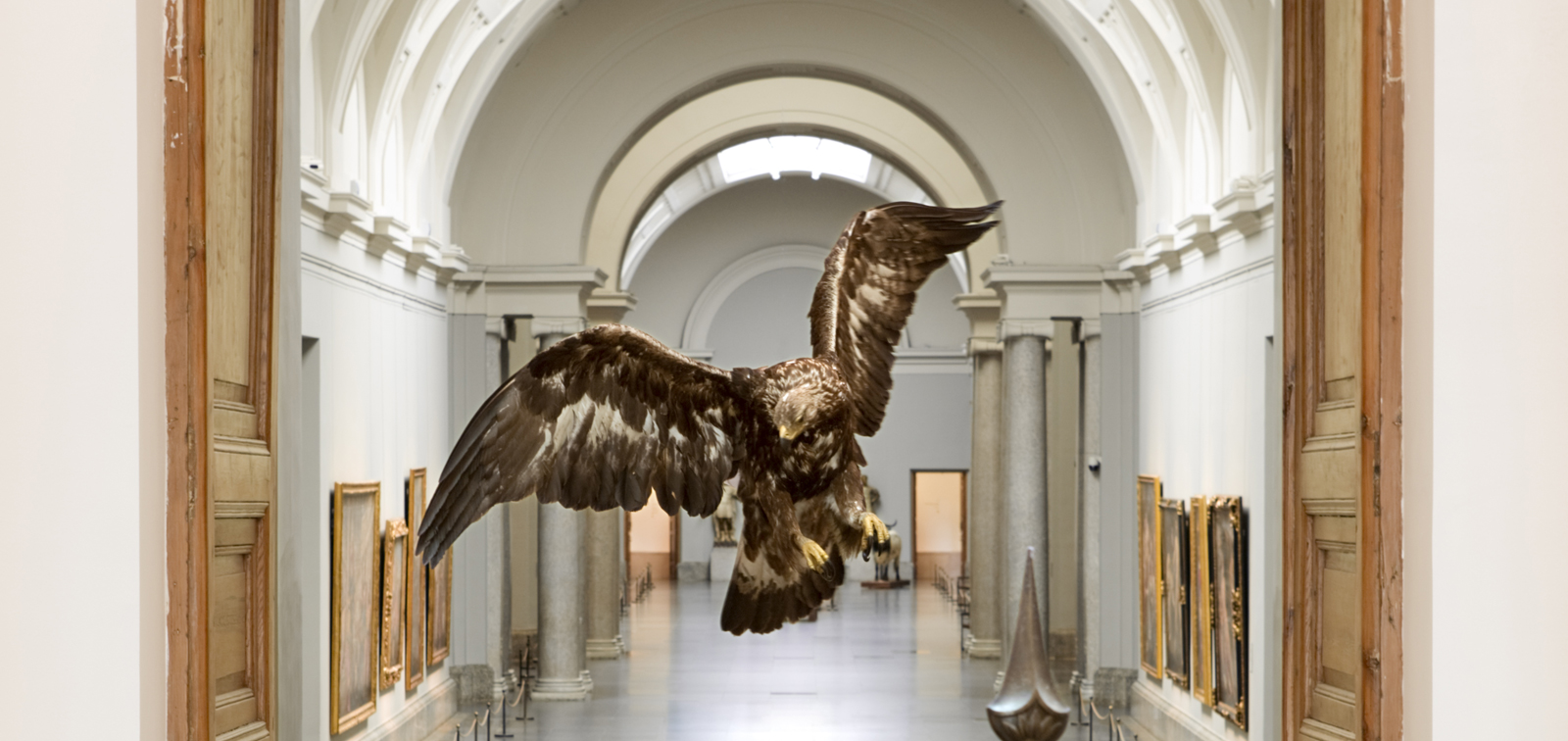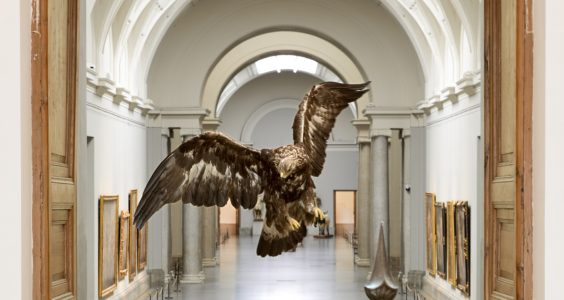MUSEO NACIONAL DEL PRADO, MADRID. NOVIEMBRE 2013 – ABRIL 2014
El público visitante del Museo ve cumplidos los deseos de Carlos III de albergar en el edificio Villanueva un Gabinete de Historia Natural. Por vicisitudes de la historia, las ciencias y las artes ya convivieron bajo el mismo techo en dos ocasiones, en 1827 y durante la Guerra Civil cuando se depositaron en el Prado piezas del Real Jardín Botánico y del Museo de Ciencias para su mejor custodia.
El artista Miguel Ángel Blanco evoca de esta forma la colección del Gabinete de Historia Natural cuyo fantasma habita en el edificio Villanueva. Las veintidós intervenciones artísticas conforman un gabinete de futuro e incorporan un punto de vista creativo, interactuando con la colección permanente y favoreciendo una nueva forma de contemplación de las obras que ayuda a su extensión imaginaria.
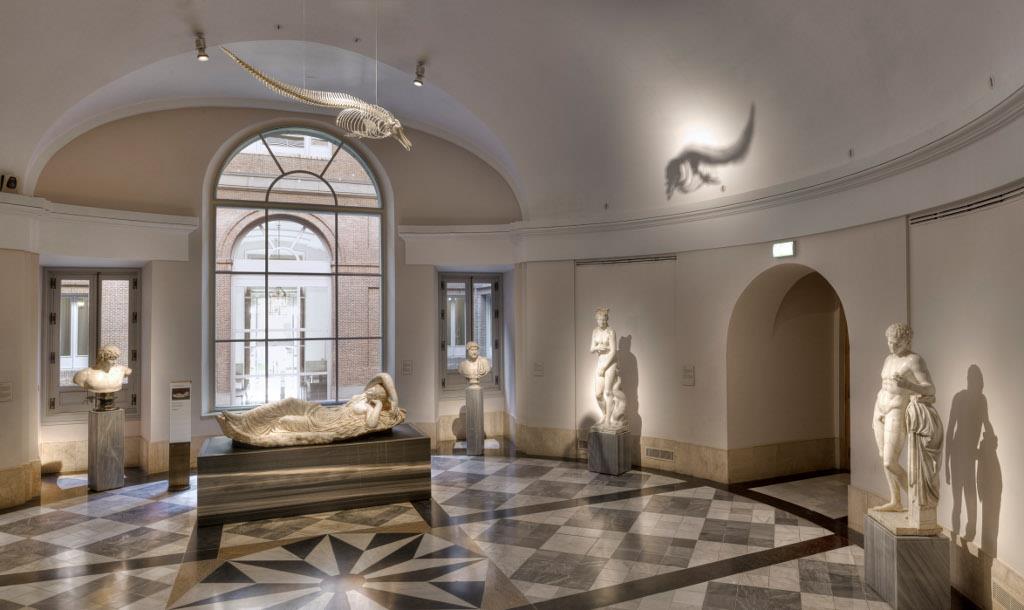
- Venus del delfín
- Taller romano, Museo Nacional del Prado
- Esqueleto de delfín
- MNCN- CSIC
El esqueleto de un delfín, suspendido del techo de la sala, acompaña a la Venus del Delfín. El animal parece haber saltado en el tiempo y en el espacio. Ha pasado de su posición mansa junto al cuerpo desnudo de la diosa hasta el presente; el tiempo lo ha convertido en un esqueleto paradójicamente lleno de vida gracias a su nueva posición. El color de sus huesos dialoga con el mármol pulido de las esculturas; al mismo tiempo, su figura resulta amenazante, como la de una criatura mítica que acecha desde las alturas.
Según la práctica común de añadir elementos a las esculturas clásicas durante el renacimiento y el barroco, el delfín de mármol fue incorporado a la escultura romana en el siglo XVII. El esqueleto es así un nuevo añadido contemporáneo que altera el sentido de la pieza antigua. La Venus parece retraerse, temerosa de ser engullida por el animal.
La situación flotante del delfín sugiere el gesto de la natación y convierte a esta sala, la llamada rotonda de Ariadna, en un espacio imaginario cargado de agua. De hecho, presenta otras referencias acuáticas: el busto de Antinoo, que murió ahogado por la corriente del Nilo; la Ariadna recostada en la playa de la isla de Naxos; y esta Venus, nacida de la espuma del mar.
En los antiguos gabinetes de las maravillas fue frecuente la yuxtaposición de esculturas clásicas con objetos naturales. En ocasiones, por falta de espacio, se suspendían del techo las piezas de mayor tamaño, creando diálogos sorprendentes como el que se sugiere en esta sala.
El Edén enjoyado
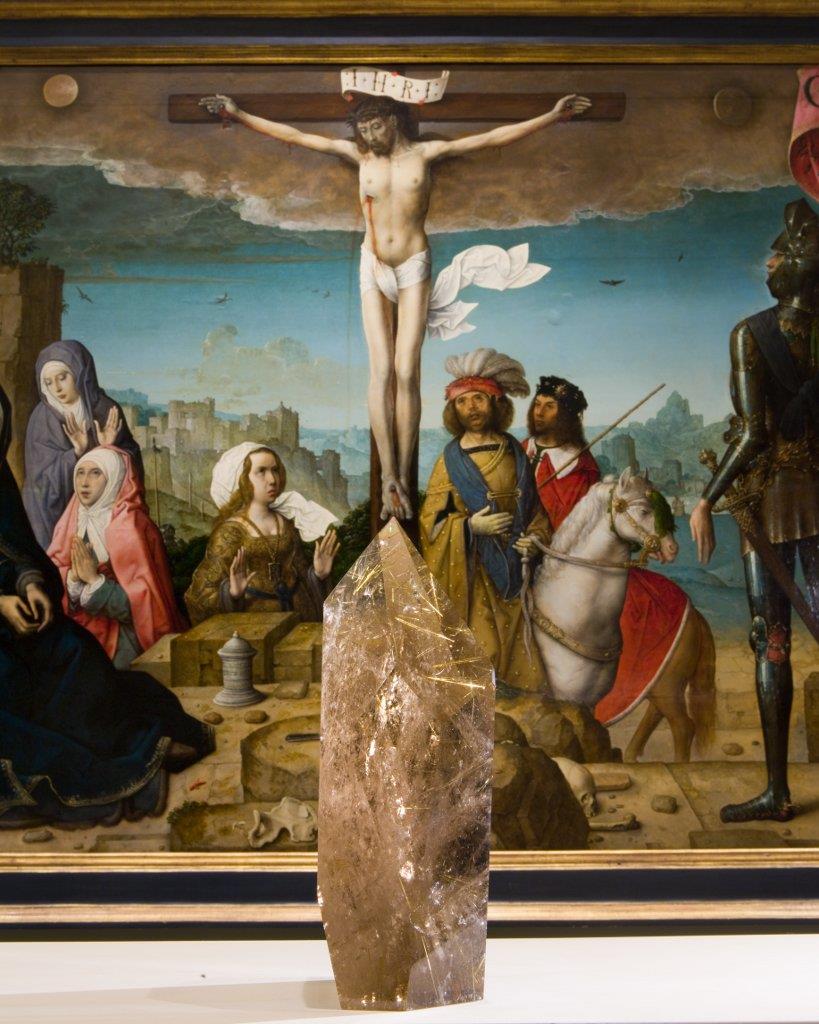
Este conjunto de piezas está formado por diversas gemas, un fragmento de coral rojo y el llamado “cráneo verde”, hallado en El Milagro, una de las minas más antiguas del mundo. Este resto óseo cobró su peculiar color al estar sometido durante milenios al carbonato de cobre. El resultado es la impactante imagen de la cabeza coloreada de un minero de 4000 años de antigüedad cuyos restos fueron devueltos a la roca que trabajaba.
En las representaciones de la crucifixión, como la de Juan de Flandes que acompaña esta instalación, era frecuente situar, a los pies de la cruz, un cráneo y otros huesos humanos. Se hacía referencia así a la tumba de Adán en el Gólgota y a la salvación del hombre más allá de la muerte.
Lo que resulta menos frecuente es la inclusión de corales y gemas. El coral, situado junto a los pies de la Virgen, simbolizaba la sangre de Cristo. De izquierda a derecha, por debajo de su manto aparecen una espinela o un granate; las piedras redondeadas y perladas serían adularias o piedras de la luna; en la roca sobre la que descansa el cráneo, la piedra más pequeña es un cabujón de zafiro, la alargada es un cristal de roca; a su derecha, un zafiro de agua, y delante de la tibia, un rubí; junto a los pies del soldado hay zafiros.
Miguel Ángel Blanco recupera la tradición de incluir materiales geológicos en los gabinetes de las maravillas y dialoga a través del tiempo con Juan de Flandes devolviendo a las tres dimensiones algunas de las gemas de su obra.
Dragones apocalípticos
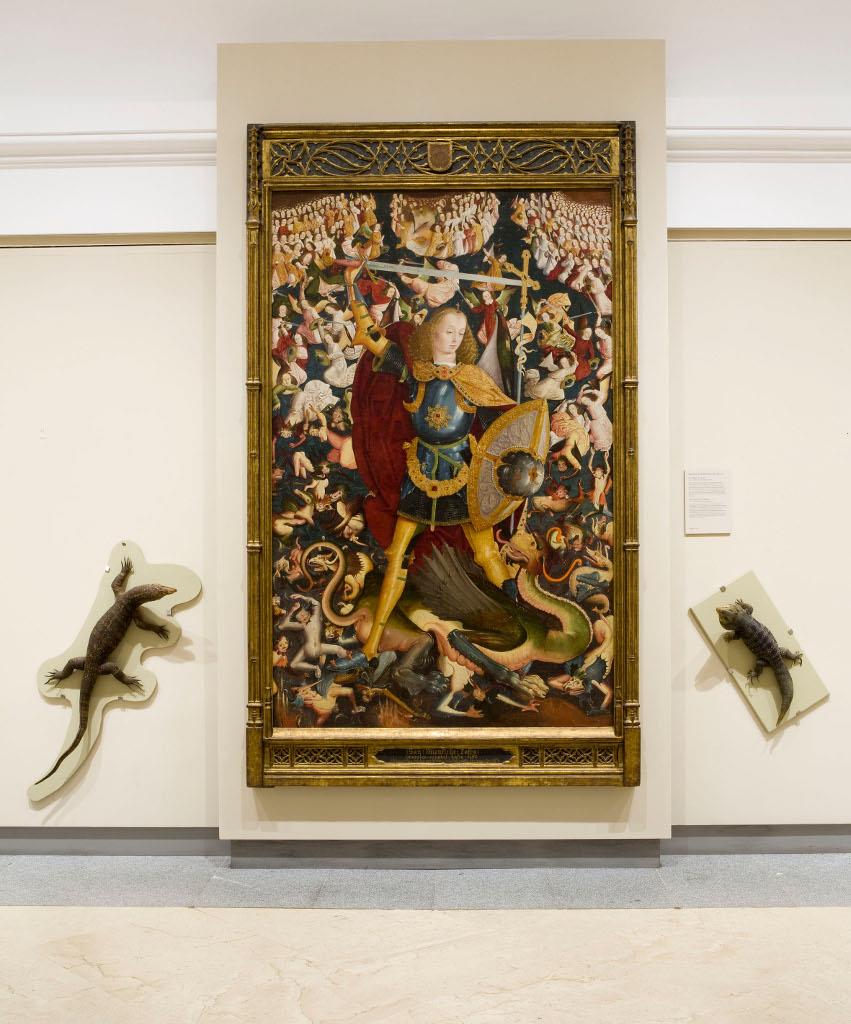
Mediante la presentación de estos dos ejemplares, el artista reflexiona sobre la dudosa reputación de los reptiles a lo largo de la historia y en la iconografía. Los animales parecen aproximarse a la obra, escoltarla o acudir en apoyo de su semejante, el dragón contra el que lucha San Miguel Arcángel. Sus dos figuras reptantes vienen a unirse a esta batalla entre lo demoníaco y lo angélico.
En el universo simbólico del cristianismo el dragón está asociado al pecado. Se trata de una figura creada por la imaginación a partir de un ave, un reptil y un león. Como la del dragón, la morfología de algunos reptiles procedentes de lugares lejanos resulta sorprendente. Así ocurre con el varano acuático jaspeado y el tegu. El primero vive en la India y zonas del sureste asiático y está emparentado con el dragón de Komodo; el tegu, por su parte, habita diversas áreas de América Latina. Ambos ejemplares fueron naturalizados a mediados del siglo XIX, cuando en los gabinetes de las maravillas se preciaban los ejemplares exóticos; el proceso de naturalización de un animal concedía una vitalidad teatral a especies ajenas a estas latitudes, al tiempo que confirmaba el control definitivo sobre su agresividad.
De modo similar, el Maestro de Zafra, responsable de la obra pictórica, otorga vida mediante la pintura a una criatura proveniente de otros mundos: los del mal, lo demoníaco y lo amenazante; y, de ese modo los convocaba y controlaba a través del gesto victorioso del arcángel.
Bosque petrificado
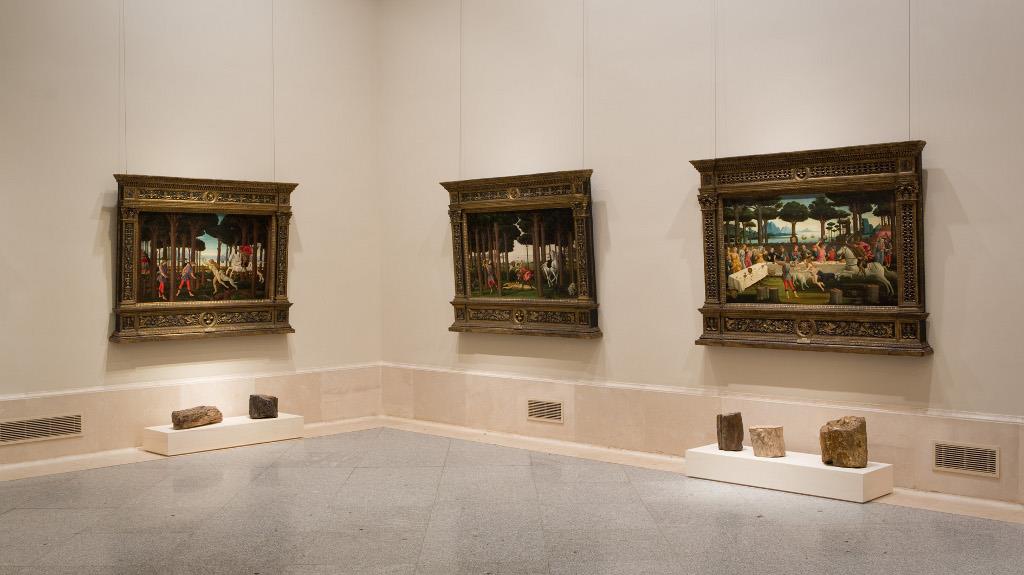 La historia de Nastagio degli Onesti I y III, Sandro Botticelli
La historia de Nastagio degli Onesti I y III, Sandro BotticelliDiversos troncos fosilizados se distribuyen en esta sala como inesperada reminiscencia de los que Botticelli plasmó en La historia de Nastagio degli Onesti. En la pintura, el bosque es tan protagonista como el resto de elementos. Funciona como fondo y, como en los cuentos tradicionales, es un personaje que asoma, acompaña e impone un ritmo al discurrir del relato. Este paisaje recoge el pinar mediterráneo propio de las inmediaciones de la ciudad de Rávena, con el gusto por la precisión científica propia del quattrocento italiano.
La narración, proveniente del Decamerón de Boccaccio, queda congelada en la pintura con el gesto entre natural y envarado propio del arte de este primer renacimiento. De manera similar, los troncos situados en la sala, fosilizados, conservan sus texturas intactas para el ojo humano. Este fenómeno fue conocido como “petrificación” en la época en que surgieron los gabinetes de las maravilla. Se imaginaba entonces que sus formas respondían a parecidos casuales con elementos naturales, hasta que la ciencia avanzó que se trataba de seres que habían vivido en tiempos remotos.
Uno de estos fósiles proviene de Petrified Forest, en Arizona, un paisaje en el que troncos de hasta 250 millones de años han aflorado a la superficie como un gran bosque talado que emerge desde la edad de los reptiles. Así surgen estos fósiles como personaje de un relato del pasado, más remoto que el recogido por Botticelli, pero capaz aún de comunicar desde su silencio.
Alas
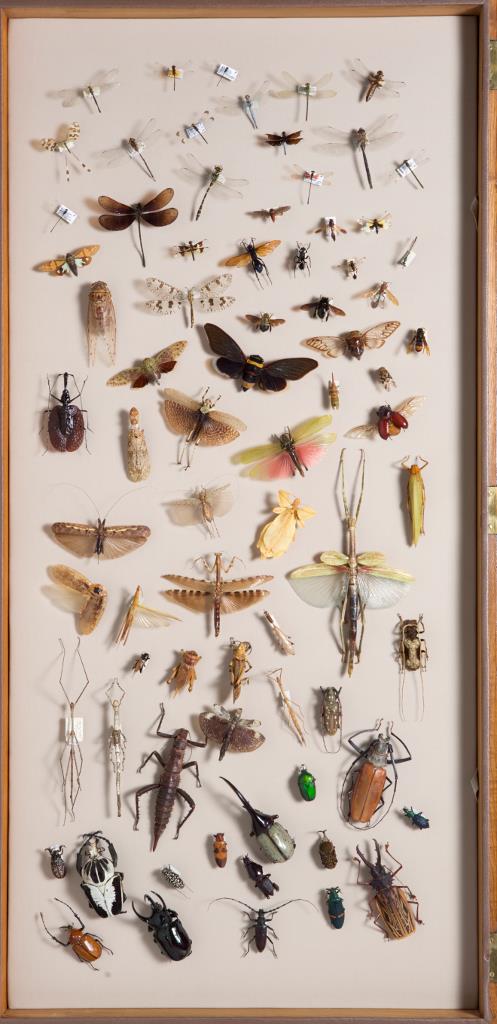
- Caja entomológica
Una caja entomológica con diversas variedades de insectos se asocia al peculiar universo iconográfico de El carro de heno, de El Bosco. Miguel Ángel Blanco ha imaginado el tríptico pictórico como ser volador con sus alas desplegadas y ha añadido, respetando las dimensiones del cuadro, este nuevo panel.
La caja contiene, entre otros, ejemplares de libélulas y caballitos del diablo, escarabajos, cigarras, hormigas león, insectos palo y mantis religiosas, procedentes de muy diversos lugares del planeta.
La entomología tuvo su lugar en el Real Gabinete de Ciencias Naturales y aún lo conserva en el Museo del Prado a través de obras como ésta de El Bosco. En el panel derecho de El carro de heno aparecen varios seres de naturaleza híbrida; entre ellos, los insectos representan las facetas más oscuras de la psique humana, en apoyo del discurso sobre el pecado que despliega el tríptico. El Bosco respondía así al interés por la historia natural de parte de su clientela; muchas de las especies que reprodujo solo podían verse en aquellos tiempos en los primeros gabinetes científicos.
Una laguna de azurita
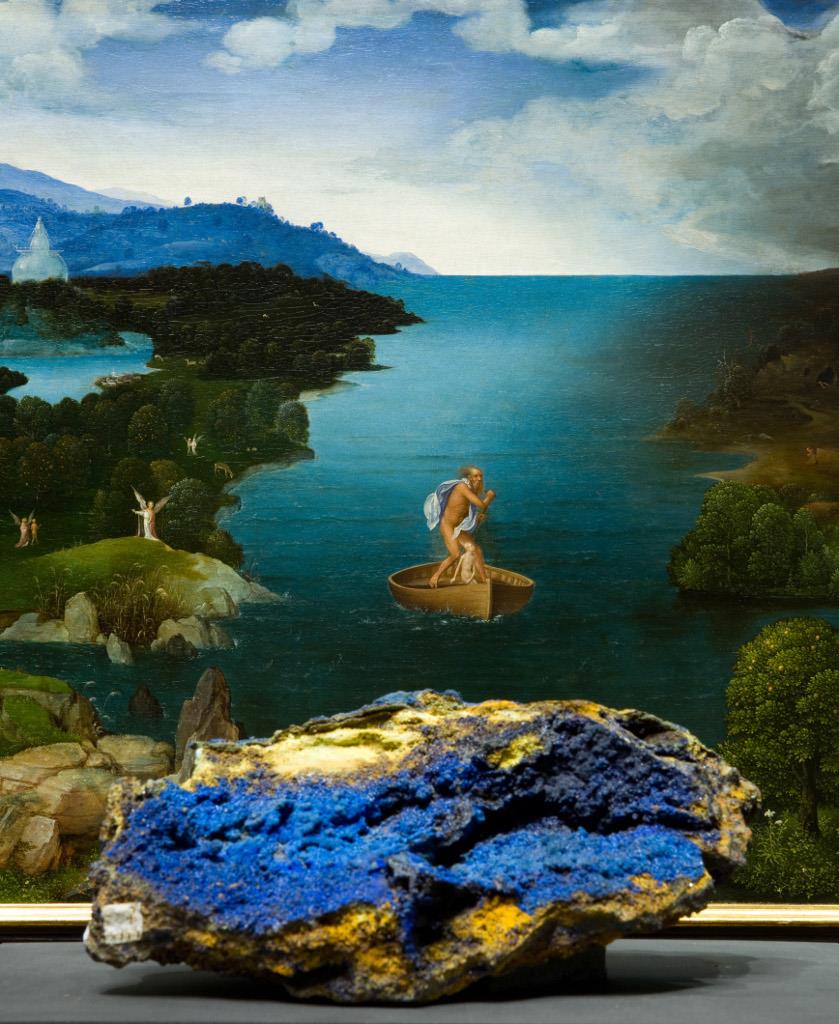
- El paso de la laguna Estigia
- Joachim Patinir
- Museo Nacional del Prado
- Azurita gigante
- MNCN- CSIC
Ante El paso de la laguna Estigia de Joachim Patinir, la presencia de una azurita gigante recuerda cuál es el origen de la presencia azul que protagoniza el centro del cuadro. Este mineral fue utilizado como pigmento para la obra. Su uso era frecuente en la antigua China y pasó a Europa durante la Edad Media.
He aquí otro de los puntos de contacto entre la ciencia y las colecciones del Museo del Prado: la mayor parte de la pintura antigua que aquí se admira tiene su origen primero en pigmentos naturales, previos a la invención de los pigmentos sintéticos. Esto significa que el mineral, en este caso, está a la vez en el cuadro, es decir, en sus capas pictóricas; y junto a él, mediante la presencia de la azurita gigante. A la perspectiva creada por Patinir, Miguel Ángel Blanco añade un primerísimo plano que dialoga con el cuadro desde la pureza material del mineral. En la piedra se puede imaginar el resultado de la desecación de la laguna Estigia, la que separaba para los griegos el mundo de los vivos y el inframundo de los muertos.
Anatomías comparadas
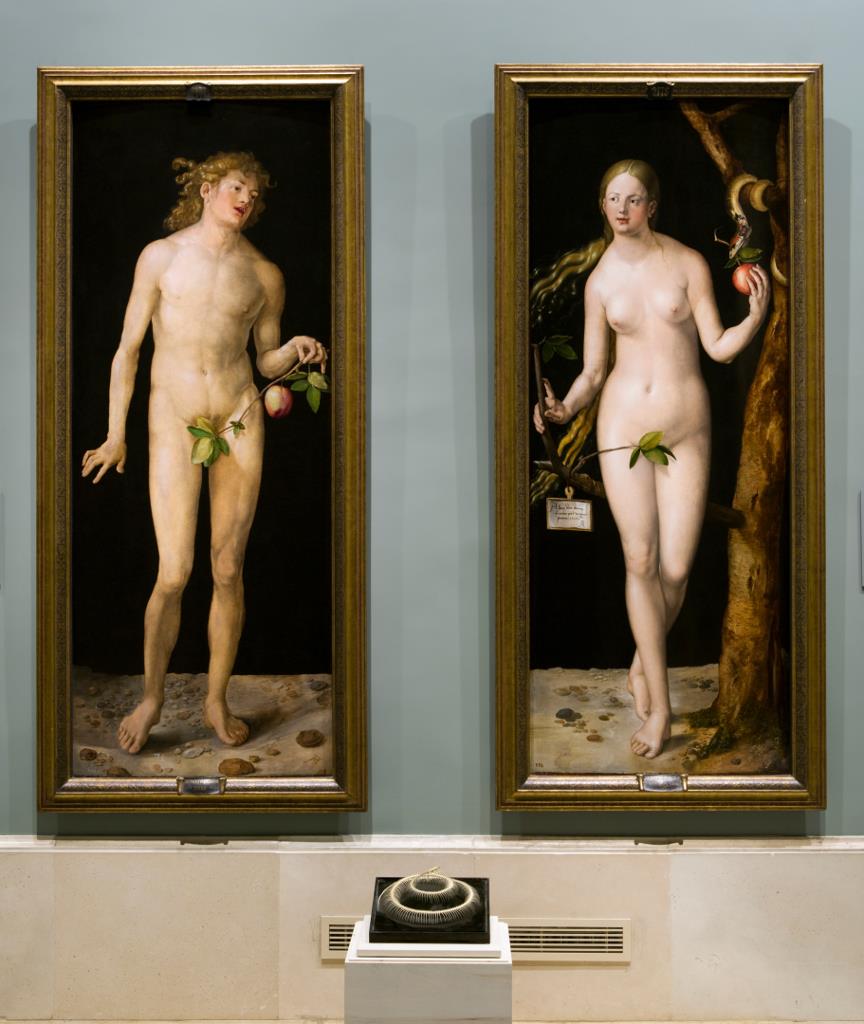
- Adán y Eva, Alberto Durero
- Museo Nacional del Prado
- Esqueleto de serpiente
- MNCN – CSIC
La Eva de Alberto Durero es una obra marcada por la presencia amenazante y seductora de la serpiente que, según el Génesis, condensa la tentación y el pecado. Ante ella, un esqueleto de este animal parece dar vida a la criatura bíblica a través de sus restos óseos recompuestos.
El ejemplar fue reconstruido para ser utilizado como material didáctico en el estudio de la anatomía animal. Aquí yace otro vínculo con la obra de Durero, también relacionada con el estudio científico de la anatomía, en este caso humana, durante el Renacimiento. La elección de la postura de la serpiente por parte de sus montadores, que realizaron el trabajo a mediados del siglo XIX, tiene una ambición estética y no sólo científica. Las curvas que dibuja se hacen eco de la sinuosidad y sensualidad de las figuras de Durero y su aspecto despojado incide en el carácter enigmático que este animal tiene en la pintura.
La historia traza otro vínculo entre la pareja de Durero y la serpiente como animal que representa lo prohibido y lo peligroso: el propio Carlos III, tras pensar en quemar ambos cuadros, mandó ocultarlos. Fueron conservados durante años para su uso exclusivo con fines de estudio anatómico. El conjunto presentado es así una suerte de propuesta de anatomías comparadas.
Bosques negros
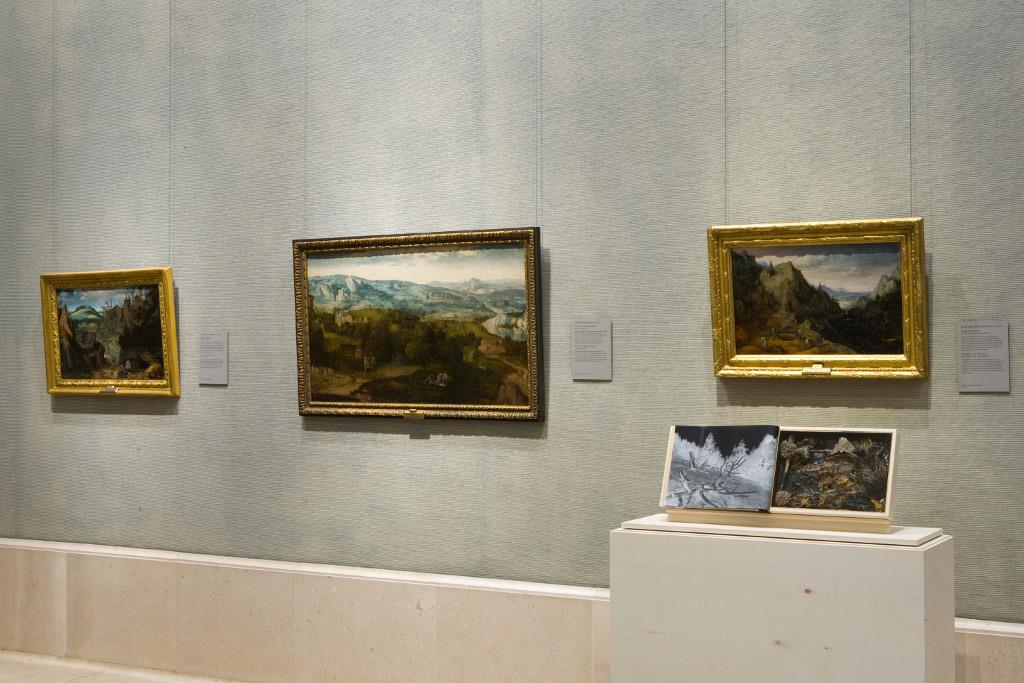
- Paisaje con ferrerías, Lucas van Valckenborch
- Museo Nacional del Prado
- Bosque negro, Libro-caja nº 24.3-2009, Miguel Ángel Blanco
- Colección Biblioteca del Bosque, libro nº 1072
Un gabinete de las maravillas en forma de libro, con elementos procedentes de todos los reinos de la naturaleza, recibe al visitante ante tres paisajes del siglo XVI. Se trata de un tipo de pieza en la que Miguel Ángel Blanco lleva trabajando desde hace décadas: son libros que, en su conjunto, generan una biblioteca de lo natural en la que caben lo común y lo extraordinario. Recolectados por Blanco en distintas zonas, cada uno de los elementos que forman estos libros, al ser seleccionados y presentados, toman la cualidad de algo raro y preciado.
Este es el caso del libro Bosque Negro, en el que el artista dialoga con los primeros paisajistas, atentos observadores de la naturaleza. Recoge diversos fragmentos de acículas, cortezas, resina, líquenes y estróbilos, que incorpora al libro sobre un fondo de cera y resina; preceden a la caja una serie de páginas con fotografías alteradas del lugar, impresas sobre papel vegetal.
El bosque negro de Miguel Ángel Blanco reflexiona sobre el paisaje en la pintura, género en el que es común la selección y disposición caprichosa de elementos de la naturaleza aislados de contexto. Esta obra remite también al uso que el artista hace del propio museo, como si se tratara de una caja en la que ha introducido elementos naturales con una significación histórica y personal.
El furor de las águilas

- Carlos V y el Furor, Leone y Pompeo Leoni
- Museo Nacional Prado
- Águila Real
- MNCN – CSIC
El águila real, situada junto a la escultura Carlos V y el furor, de Leone Leoni, nos recuerda la omnipresencia del simbolismo animal a lo largo de la colección del Museo del Prado. Tal vez el caso más paradigmático, por haber mantenido su vinculación al poder desde la antigüedad, sea el del águila. En la escultura, entre otros animales, un ejemplar de esta especie corona la empuñadura de la espada del emperador. Eco de ese elemento decorativo, como si hubiera crecido desde su posición en el bronce, se presenta este águila naturalizada, es decir, con su cuerpo escenificando una postura propia de su especie. Parece así independizarse de su referente simbólico, y amenazar al emperador en posición de ataque, suspendida del techo de museo.
El águila entró en el mundo cristiano a través de Carlomagno, que la recuperó de Roma, donde había sido el símbolo imperial por antonomasia. Es el animal asociado al dios Júpiter en el que se vincula el poder militar y político. Sus alas extendidas sugieren la imagen del control unipersonal de un vasto territorio. Los Austrias utilizaron la variante del águila bicéfala, una criatura de invención bizantina que hace pensar en el gusto por lo monstruoso de los primeros coleccionistas de piezas naturales.
El Diluvio fosilizado
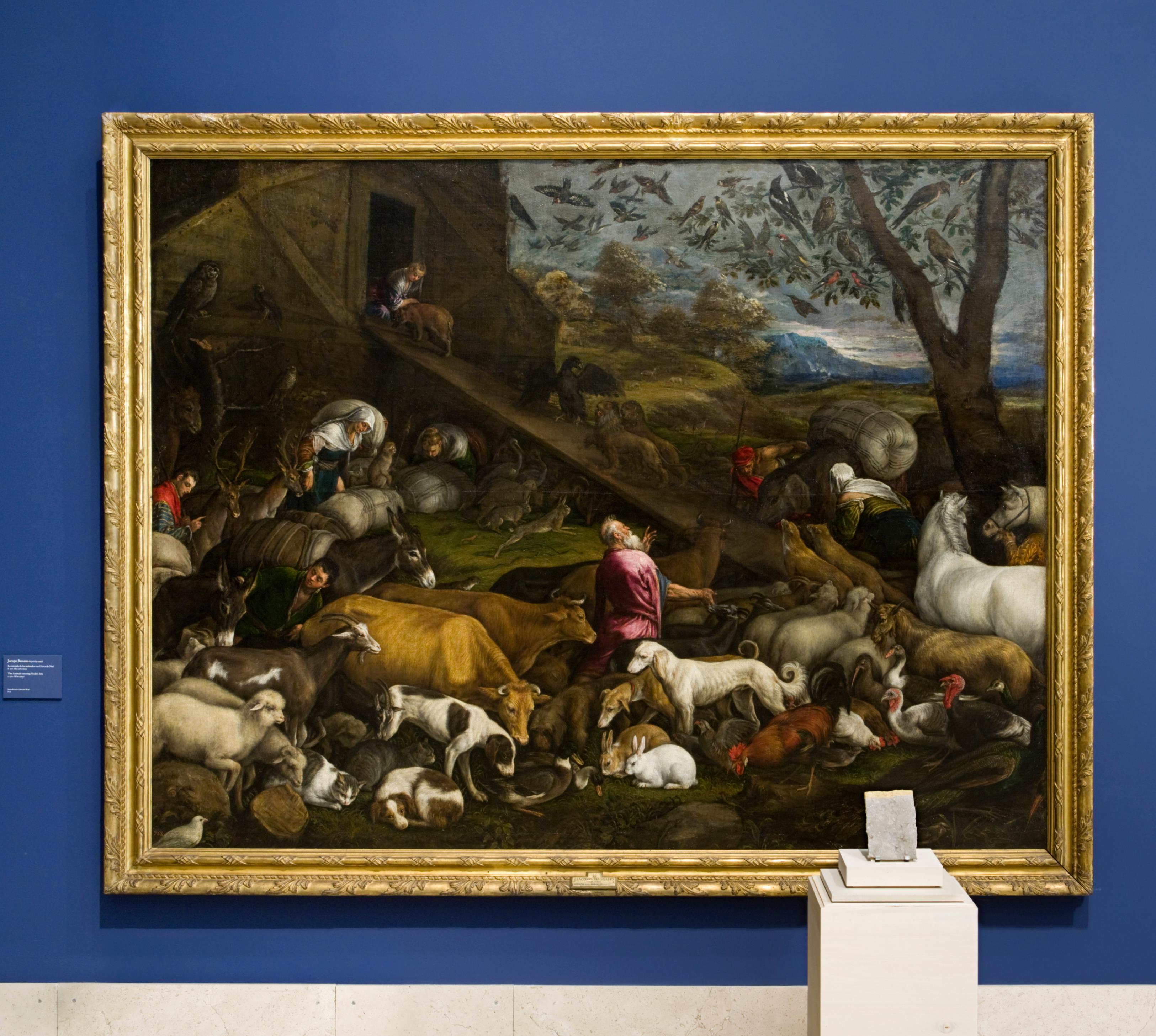
- Entrada de los animales en el arca de Noé, Jacopo Bassano
- Museo Nacional del Prado
- Impresiones fósiles de gotas de lluvia
- Museo Histórico Minero Don Felipe de Borbón y Grecia de la Escuela técnica Superior de Ingenieros de Minas y Energía
Unas gotas de lluvia fosilizadas acompañan Entrada de los animales en el arca de Noé de Jacopo Bassano. Estas impresiones en la piedra parecen traer a la sala del museo el resto que sugiere la existencia de un diluvio acaecido en tiempos remotos; junto a las gotas de agua, aparece la huella de un animal sin identificar. Provienen del Green River, en Estados Unidos; lo que allí desapareció, no obstante, no fueron los animales que plasma Bassano, sino dinosaurios.
La exploración de nuevas tierras y la expansión de las ciencias naturales durante la Edad Moderna pusieron en entredicho muchas creencias religiosas. Una de ellas fue la veracidad del relato bíblico relativo al arca de Noé. Algunos gabinetes de las maravillas incluyeron reliquias del mítico barco, mientras el hallazgo de gotas fosilizadas supuso para muchos la confirmación de que el desastre bíblico había tenido lugar.
El relato del arca reverbera de manera indirecta en la época de las grandes expediciones científicas que hacían acopio de especies animales de ultramar para traerlas a Europa. El flete de aquellos barcos y la difícil aclimatación y traslado de especies traían al presente, y de alguna manera ponían en escena, la narración de aquel texto del Antiguo Testamento.
Un pescado peregrino
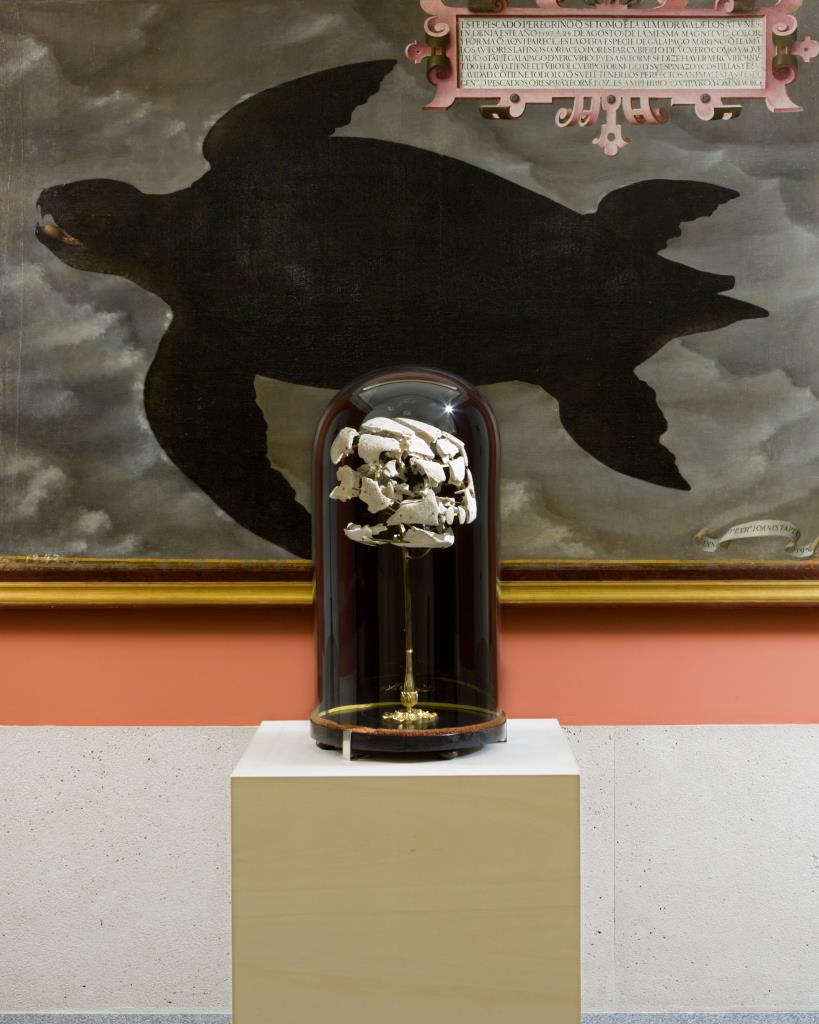
- Tortuga laúd, Pedro Juan Tapia
- Museo Nacional del Prado
- Fanal con cráneo de tortuga
- MNCN
La obra de Pedro Juan Tapia, Tortuga laúd, ha sido exhumada de los almacenes del museo expresamente para esta presentación. Junto a ella, Miguel Ángel Blanco ha situado un fanal con un cráneo de tortuga expandido, estableciendo un diálogo entre realidad y representación, pasado y presente de un mismo elemento vivo.
La obra de Tapia fue encargada para el gabinete de curiosidades de Felipe II, un rey que no desdeñó el coleccionismo de naturaleza entre los importantes conjuntos de objetos valiosos que acumuló en el Escorial. Cuando no se podía conseguir un ejemplar codiciado, cuadros como éste venían a suplir su ausencia.
La presencia pacífica de la tortuga pintada contrasta con el aspecto amenazante de su cráneo bajo el vidrio; lo que parece señalar una posible etimología de la palabra Tortuga: la tartaruca, habitante del Tártaro, es decir, del infierno. Una oscura reputación procedente de su aspecto arcaico y taciturno que, sin embargo, no está presente en otras culturas. En Japón, por ejemplo, es considerado un animal celestial, símbolo de longevidad, protección, riqueza y prosperidad.
Alicornios

- Orfeo y los animales, Padovanino
- Museo Nacional del Prado
- Diente de Narval
- MNCN
De entre las piezas presentes en un gabinete de las maravillas, una de las joyas era el alicornio, el preciado cuerno de un supuesto unicornio. Algo similar ocurre en el cuadro de Padovanino Orfeo y los animales. Aquí destaca esta criatura entre los asistentes a la interpretación musical del personaje que representa la inspiración musical y poética y su relación con el mundo natural. En las edades media y moderna, el animal simbolizaba a Cristo y era emblema de la pureza.
Miguel Ángel Blanco se pregunta cómo es posible que se mantuviera el engaño acerca de la existencia del unicornio durante tantos siglos. Así lo muestra la presencia de doce alicornios en la colección de Felipe II, piezas que tenían el valor de veinte veces su peso en oro y eran a la vez un amuleto, un talismán, un arma y un botiquín.
Bodegones experimentales
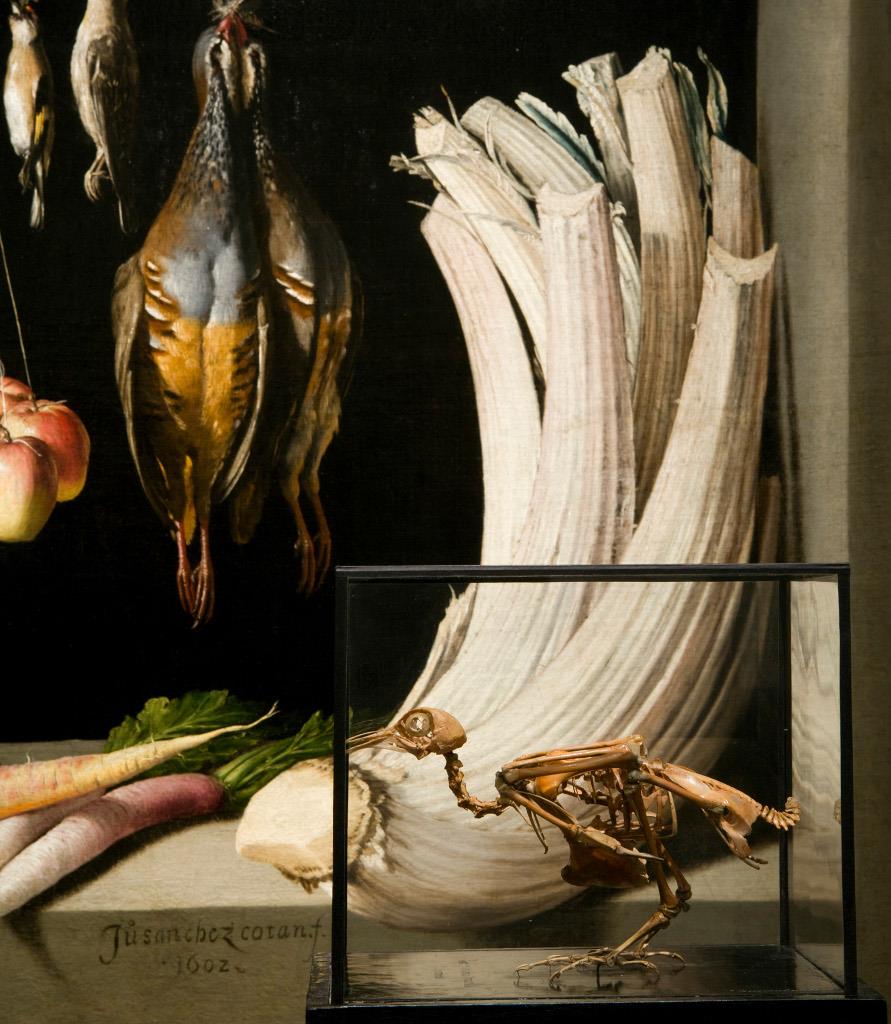
- Bodegones experimentales
- Bodegón de caza, hortalizas y frutas
- Juan Sánchez Cotán
- Museo Nacional del Prado
- Esqueleto de pichón
- Museo Nacional de Ciencias Naturales
Esqueletos de palomas tintados – Bodegón de caza, hortalizas y frutas de Sánchez Cotán (sala 8 A)
Del Bodegón de caza, hortalizas y frutas de Sánchez Cotán parece desprenderse, en posición natural, el esqueleto de una paloma. El pintor barroco contribuyó en buena medida al perfeccionamiento de la representación de elementos naturales a través del género de la naturaleza muerta. Por su parte, Mariano de la Paz Graells, el responsable del experimento que dio lugar a estos esqueletos de paloma tintados, aportó a la ciencia un peculiar método de estudio de la osamenta de estas aves. Para obtener esta coloración alimentó a las palomas con ruda, una planta medicinal que provoca el tintado de los cartílagos, distinguiéndolos así de los huesos.
El interés de Miguel Ángel Blanco por la creación de cajas en las que se recogen fragmentos del mundo natural encuentra referentes remotos en estas dos piezas: tanto en la obra de Sánchez Cotán, especie de receptáculo que ofrece sus productos naturales, como en el esqueleto tintado, situado también de manera teatral en el interior de una caja con sus alas abiertas.
El toro de Veragua
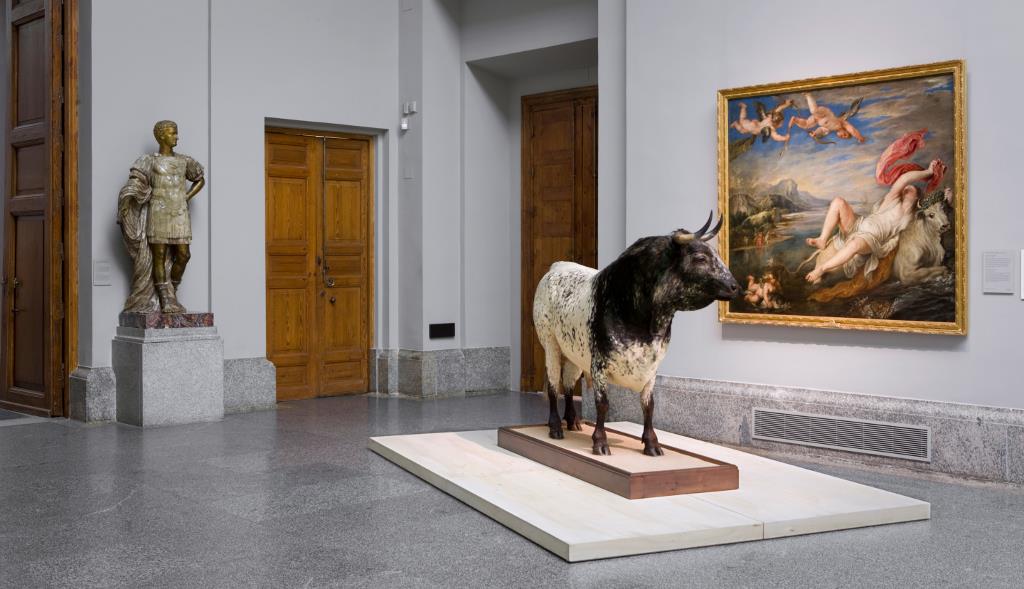
- El Toro de Veragua (Sala 29)
- El Rapto de Europa
- Pedro Pablo Rubens
- Museo Nacional del Prado
- Toro de Veragua
- MNCN – CSIC
- Foto: Pedro Albornoz/Museo Nacional del Prado
Toro veragua – El rapto de Europa de Rubens (sala 29)
El toro fue una de las muchas metamorfosis de Zeus. Como muestra la obra de Rubens El rapto de Europa, el dios tomó la forma de un hermoso toro blanco para seducir a la mujer cuando esta se acercaba a acariciarlo. Zeus engañó a Europa con su mansedumbre y la raptó cuando ella, confiada, subía a su lomo. El mismo efecto de engaño a la vista, de presencia atractiva y amenazante produce la presencia en la sala de un museo de un toro naturalizado.
Este animal fue disecado siguiendo el modelo de la dermoplastia, consistente en la creación de una detallada escultura de yeso del animal a la que se fijaba la piel del animal desollado.
La figura del Zeus-toro aparece en otras obras del Prado firmadas por Tiziano y Velázquez, recordando así el linaje común de los tres grandes maestros del Prado. En el toro bravo también el linaje y la nobleza son elementos fundamentales: este ejemplar es un veragua, una de las cinco únicas castas fundacionales de la ganadería de lidia.
Conservatorio para pájaros
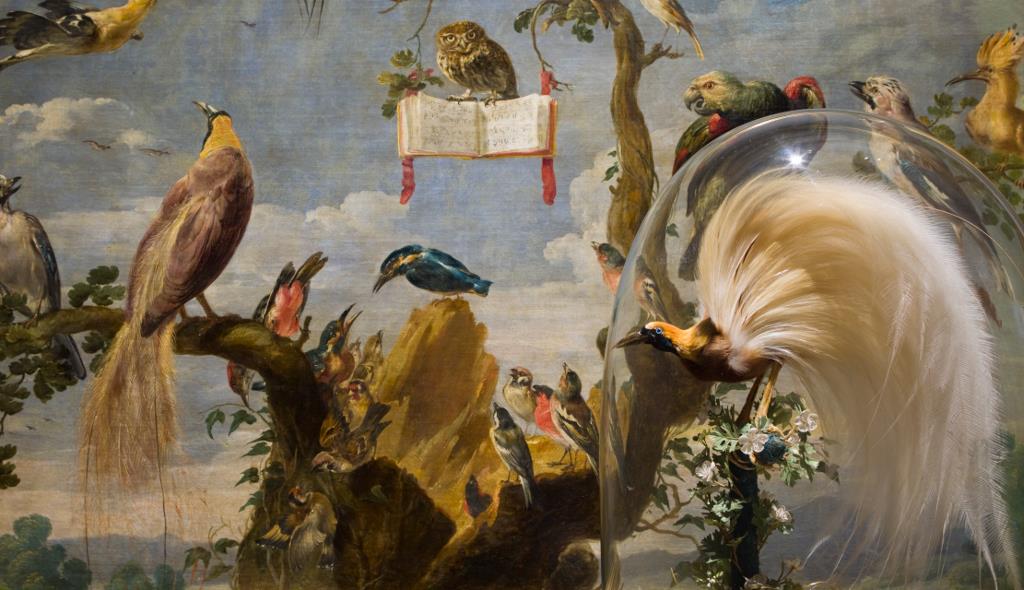
- Conservatorio para pájaros
- Concierto de aves
- Frans Snyders
- Museo Nacional del Prado
- Ave del paraíso
- MNCN – CSIC
- Foto: Pedro Albornoz/Museo Nacional del Prado
Ave del paraíso – Concierto de aves de Frans Snyders (sala 16 B)
Un ave del paraíso acompaña, desde dentro de su fanal, al concierto de aves que despliega el lienzo de Franz Snyders. Los conciertos de aves fueron frecuentes en la pintura y en la música. Entre los siglos XVI y XVIII, numerosas composiciones se basaron en el canto de los pájaros; dentro de la monarquía española, es conocido el caso de Farinelli, que compuso un canto para ruiseñor interpretado por él mismo con el fin de aliviar las crisis depresivas del rey Felipe V. De modo similar, las aves tuvieron una importante presencia entre las colecciones de animales vivos: Felipe IV convirtió el hoy desaparecido Palacio del Buen Retiro en una enorme pajarera, mientras que Carlos III se hacía acompañar por diferentes pájaros en sus estancias privadas incluso durante las horas de sueño.
En los gabinetes las aves se coleccionaban disecadas, como este ave procedente de Indonesia, que se une a este concierto, desde el aislamiento del vidrio.
Los rayos de Júpiter
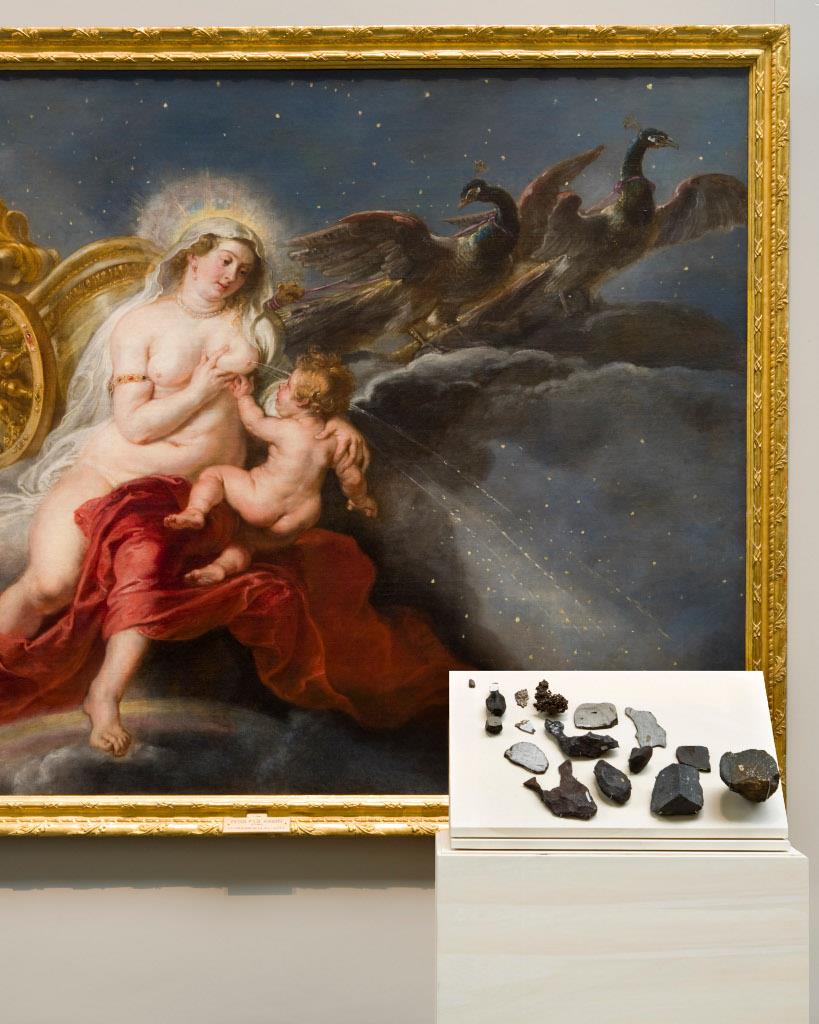
- Los rayos de Jupiter
- Colección de meteoritos con El Nacimiento de la Vía Láctea
- Rubens
- Museo Nacional del Prado
- Museo Nacional de Ciencias Naturales – CSIC
- Foto de Pedro Martínez de Albornoz/Museo Nacional del Prado
Colección de meteoritos – El nacimiento de la Vía Láctea de Rubens (sala 29)
Algunos fragmentos de meteorito acompañan El nacimiento de la Vía Láctea, obra de Rubens que narra el origen divino de esta galaxia. La aproximación mitológica a los fenómenos astrales visibles e intangibles se une al abordaje científico de una presencia tangible: la de los meteoritos que se precipitan sobre la tierra. Según el mito, la diosa Juno, al rechazar a su hijastro Hércules, esparció la leche de su pecho por el cosmos, creando esta “vía de la leche”. Estos fragmentos de cuerpos astrales parecen haberse desprendido del estrato pictórico para posarse junto a la obra y devolver a la tierra en forma de roca las gotas de aquel relato mítico. La mayoría de meteoritos que se desprenden sobre nuestro planeta provienen de un espacio legendario, el cinturón de asteroides situado entre Marte y Júpiter, dos planetas con nombre de dios potente y amenazante como la fuerza de estos fragmentos al desprenderse de la bóveda celeste.
Del mismo modo que el cuadro de Rubens alude al germen de una galaxia, dos de los meteoritos presentes en la vitrina remiten a sendos momentos fundacionales de la ciencia de la astronomía. El llamado meteorito de Allende es una estructura que se remonta a los orígenes del sistema solar; mientras el meteorito de Sigena es el primero documentado de los que se han precipitado sobre el territorio español a lo largo de la historia.
El vuelo del gorrión albino
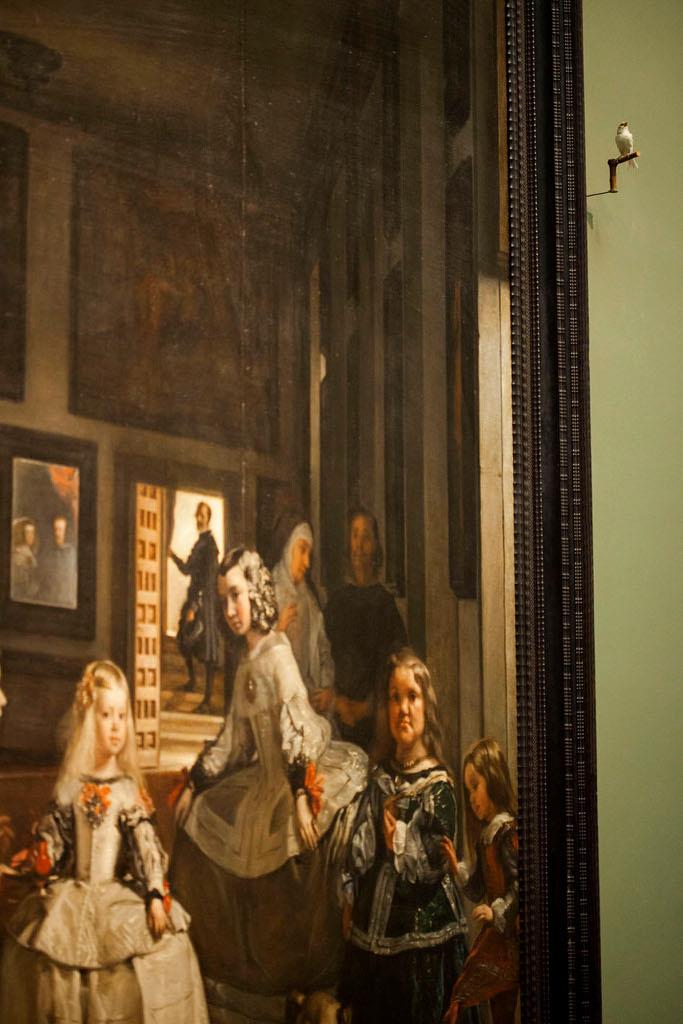
- El vuelo del gorrión albino
- Gorrión albino – Las meninas de Velázquez
Gorrión albino/blanco – Las meninas de Velázquez (sala 12)
Miguel Ángel Blanco imagina que este gorrión vuela hasta la ventana de un lugar ya desaparecido, el Alcázar de los Austrias, para desde allí observar un instante cotidiano de la corte de Felipe IV. Del mismo modo que la infanta y sus acompañantes asisten al posado de la pareja real ante el pintor, este gorrión se posa a observar y establece un duelo imaginario con otro animal, el perro que descansa sobre el suelo del cuadro.
El ejemplar proviene del Museo de Ciencias Naturales y su presencia aquí responde a la temprana convicción del artista, desde la primera vez que lo vio expuesto, de que un día lo utilizaría con fines artísticos. Su color remite a su apellido pero no es de un blanco puro, sino semejante a los grises y plateados que motean la pintura de Velázquez. Medirse con el maestro sevillano ha sido la difícil tarea de numerosos creadores a lo largo de los siglos. En este caso, el artista considera que ese desafío sólo es posible desde el aire, desde la rara corporeidad de un ser alado. Su carácter volátil es eco del gran hallazgo técnico de Las meninas: la perspectiva aérea.
Hechizos especulares
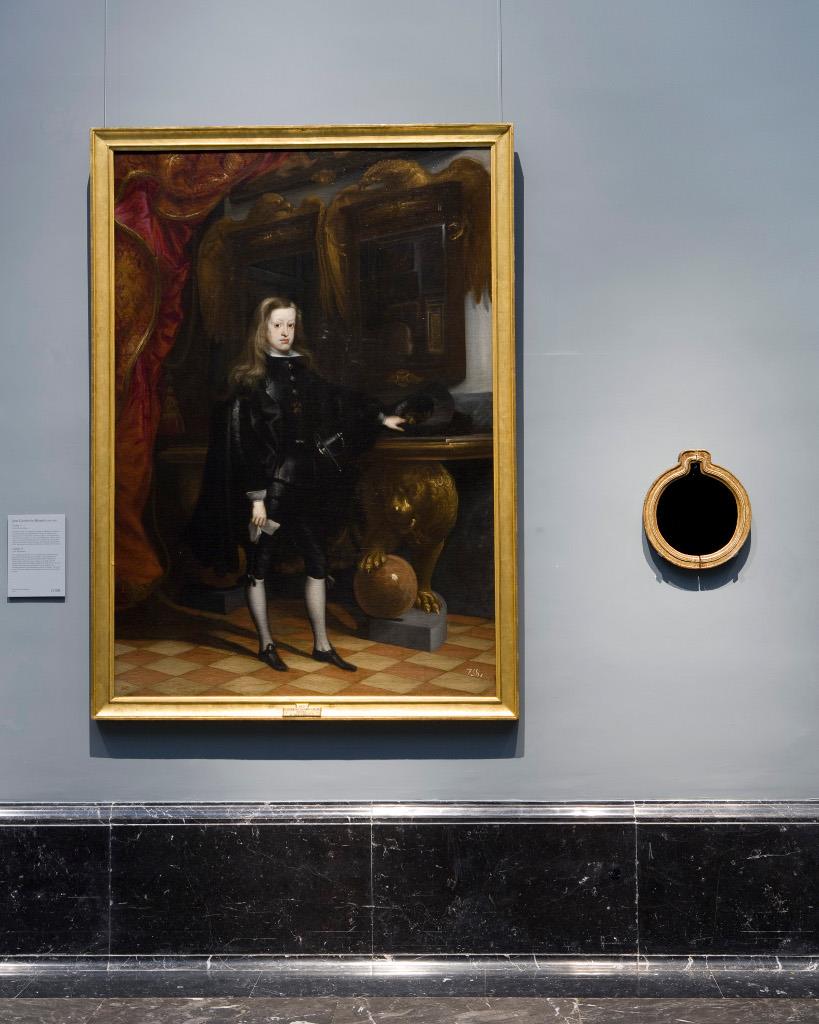
- Hechizos especulares
- Carlos II
- Carreño de Miranda
- Museo Nacional del Prado
- Espejo azteca de obsidiana pulida
- MNCN
Espejo azteca de obsidiana – Carlos II de Carreño de Miranda (sala 16 A)
Este espejo, procedente de las tierras de los aztecas, está hecho de obsidiana pulida, el material con que fueron fabricados por primera vez, hace 6000 años, estos misteriosos objetos que nos devuelven la mirada. Situado junto al retrato de Carlos II, dialoga con el espacio en el que posa el monarca: el salón de los espejos del antiguo alcázar de los Austrias. Esos nebulosos y ennegrecidos espejos que aparecen en los retratos de corte de Carreño de Miranda parecen remitir a un período sombrío como el de la decadencia del linaje Austria, y se encuentran así con la telúrica oscuridad de la obsidiana americana.
Estos espejos aztecas contaban con un orificio para colgarlos del techo de modo tal que los espíritus pudieran atravesarlos y no permanecer en ellos. Esta relación enigmática entre lo visible y lo invisible que sugieren los espejos en el inconsciente colectivo está presente en relatos de diversas culturas. Su relación con el hechizo, con lo mágico parece remitir a un rey frágil, enfermizo y estéril que recibió el sobrenombre de “el hechizado”. El monarca creyó ser víctima de fuerzas maléficas y fue sometido a diversos exorcismos. Ya su padre, Felipe IV, según las crónicas, sufrió un maleficio anónimo que alguien había ejercido sobre el espejo donde se miraba a diario.
El cruel invierno de la osa hormiguera
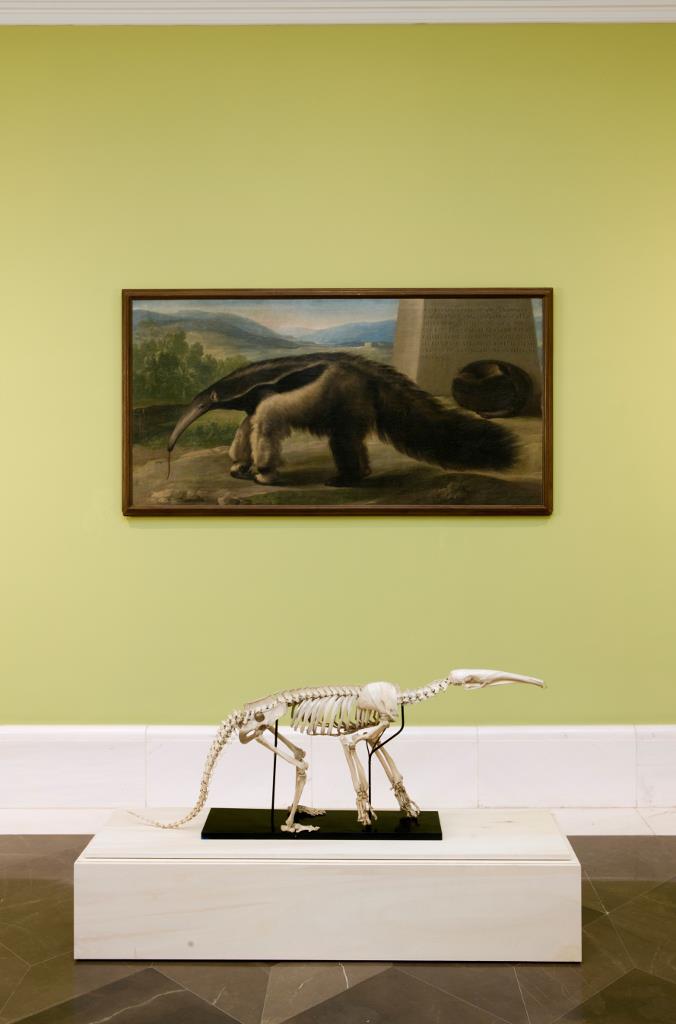
- El cruel invierno de la osa hormiguera
- La osa hormiguera de su majestad
- Taller de Antón Mengs (¿)
- MNCN, Esqueleto osa hormiguera, MNCN – CSIC
- Foto: Pedro Albornoz/Museo Nacional del Prado
Esqueleto de osa hormiguera – La osa hormiguera de Su Majestad (sala 90)
La disposición de un esqueleto de osa hormiguera junto al retrato de este animal cobra una particular trascendencia en el contexto de esta exposición. Es el único caso en el que el referente pictórico y la pieza natural coinciden: la pintura es copia del natural de una osa hormiguera traída de Buenos Aires en época de Carlos III; el esqueleto perteneció a ese mismo ejemplar. Es un raro caso en el que la pintura y su modelo conviven, una inmortalizada en el lienzo, otra mortal en su osamenta. Vuelven a unirse dos elementos que estuvieron frente a frente mientras el pintor realizaba el retrato.
El animal fue conservado en la casa de Fieras del Retiro hasta su muerte a solo seis meses de su llegada, causada por la imposibilidad de conseguir las más de 35000 hormigas y termitas que necesitaba para alimentarse. La pintura la representa en dos posiciones simultáneamente: activa y en pie, y dormida, enroscada en torno a sí misma. El cuerpo naturalizado fue conservado en el Real Gabinete de Ciencias Naturales. Hoy queda de aquella hembra de oso hormiguero su esqueleto, que parece reactivar la tranquila actividad que muestra en el cuadro, hacerla despertar del ovillo de su sueño y de su muerte prematura.
La cascarilla de la condesa
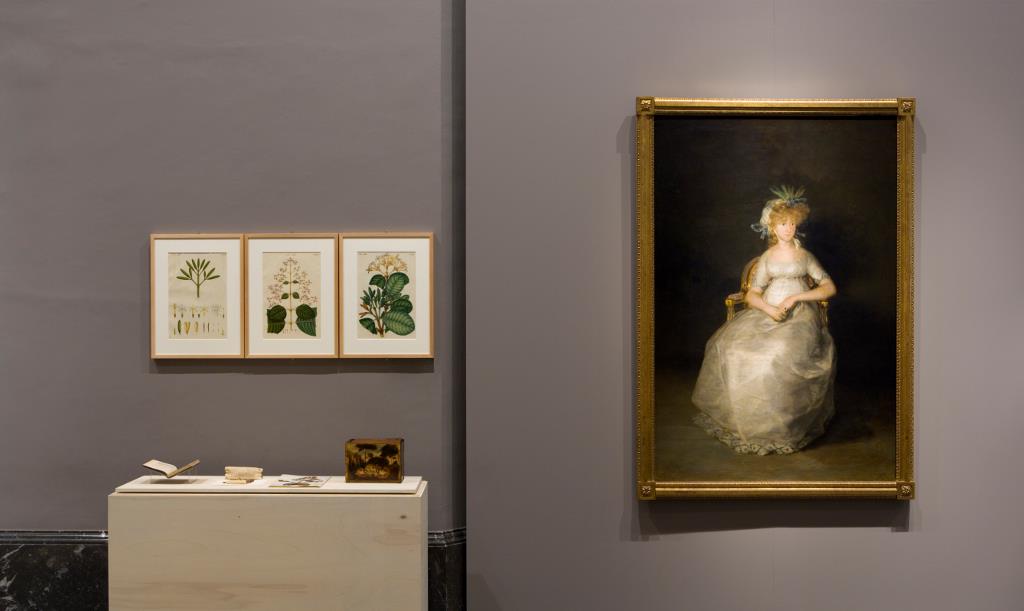
- La cascarilla de la condesa
- La condesa de Chinchón
- Francisco de Goya
- Museo Nacional del Prado
- Pliego de Cinchonapubescens, Caja de madera policromada de Cinchonapubescens. Celestino Mutis: tres láminas botánica, Cinchonapubescens (quina), Real Jardín Botánico y Museo de la Farmacia Hispana
Pliego de Cinchonapubescens, Caja de madera policromada de Cinchonapubescens. Celestino Mutis: tres láminas botánica, Cinchonapubescens (quina) – La condesa de Chinchón de Goya (sala 37)
Acompañan a La condesa de Chinchón de Goya diversos objetos relacionados con la quina, una planta apreciada por sus propiedades medicinales: se trata de seis láminas de estudio de esta especie; un pliego de la planta prensada y secada; una caja de madera policromada de quina; y un paquete de cascarilla que estuvo a la venta en los bajos del palacio donde se pintó este retrato. Esto último supone un nuevo encuentro a través del tiempo entre dos objetos.
La quina fue conocida como “cascarilla de la condesa”. Tomó su nombre del título de otra condesa de Chinchón, esposa del virrey de Perú que, en el siglo XVII, se salvó in extremis del paludismo gracias a las infusiones de esta planta. La condesa retratada por Goya no es descendiente de aquella superviviente, pues el título fue vendido. Sin embargo, además de su título nobiliario, comparte la gracilidad y fragilidad de su cuerpo con el aspecto de esta planta. Esto lleva a Miguel Ángel Blanco a asemejarlas: el elemento vegetal de las espigas que adornan la cabeza de la mujer embarazada, un tocado simbólico que alude a su fertilidad, da pie al artista a sugerir una transmutación vegetal del personaje, a rehacer el vínculo entre una planta y una mujer que comparten salud y nombre.
Invocación satánica
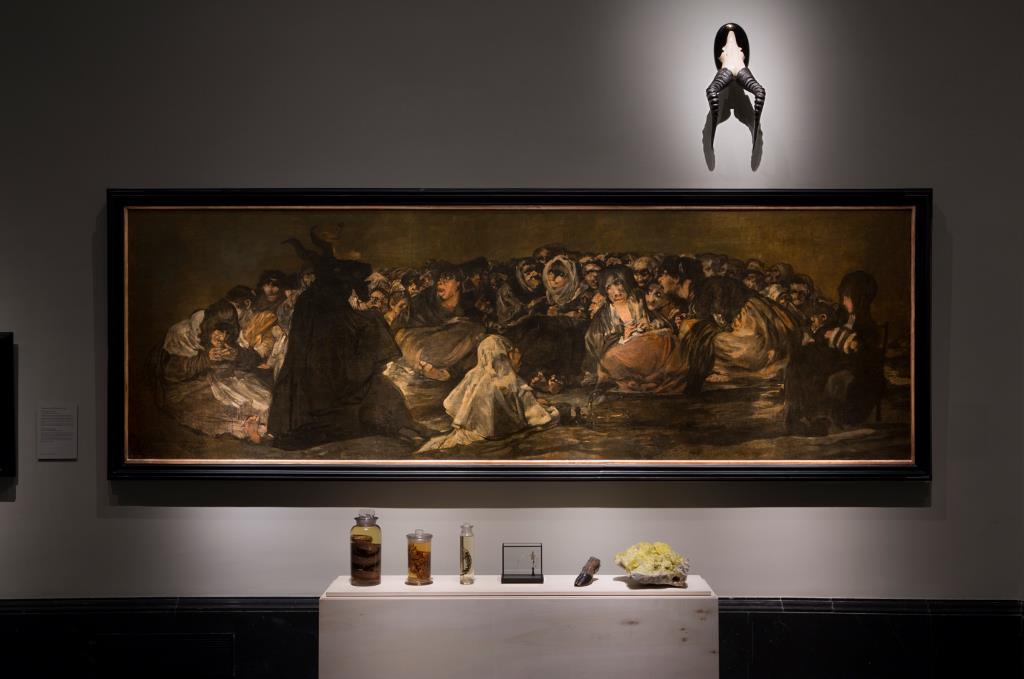
- Invocación satánica
- El aquelarre
- Francisco de Goya
- Museo Nacional del Prado
- Murciélago, salamandra, sapos, mamba negra, pezuña, piedra de azufre, cabeza de macho cabrío invertida
- Museo de la Farmacia Hispana
Murciélago, salamandra, sapos, mamba negra, pezuña, piedra de azufre, cabeza de macho cabrío invertida – El aquelarre de Goya (sala 67)
Miguel Ángel Blanco ha dispuesto, junto a El aquelarre de Goya, algunos de los más poderosos elementos que, en los tiempos de la brujería, posibilitaban la invocación del diablo. Éste se aparece, en referencia al título alternativo de la obra de Goya, El gran cabrón, en forma de macho cabrío invertido; su cornamenta abierta hacia el suelo forma el umbral que da acceso al aquelarre. Este oscuro ritual tiene un olor determinado, el del azufre que surge de la piedra situada en la vitrina; era el elemento que surgía de las infernales entrañas de la Tierra. El resto de piezas señala su papel dentro de la brujería y la medicina mágica y forma una especie de siniestra cadena alimenticia: el macho cabrío imaginario de los aquelarres se alimenta de serpientes; la cobra negra, utilizada en la magia negra africana, devora sapos, fieles compañeros de las brujas. La salamandra, por su parte, representa al fuego, aquel que devoraría a las brujas en los autos de fe de la Inquisición.
Los gabinetes de las maravillas tuvieron también su vertiente oscura, ya que transitaban entre la ciencia y la superstición, entre el coleccionismo y el fetichismo. La brujería, asunto de interés literario y pictórico en los tiempos de Goya, entraba así en el conocimiento ilustrado que alimentaba estos gabinetes seudocientíficos.
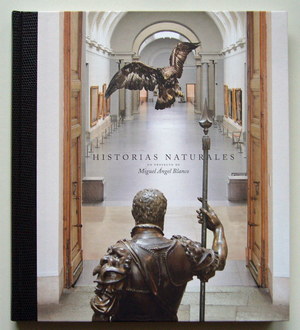
El catálogo que acompaña a la exposición contiene un texto a cargo de Miguel Ángel Blanco, autor del proyecto, titulado «La llamada del ave del Paraíso», y otro de Javier Ignacio Sánchez Almazán, conservador de la Colección de Invertebrados del Museo Nacional de Ciencias Naturales, bajo el título «De las cámaras de maravillas a los gabinetes ilustrados». También incluye un portfolio con fotografías y textos del autor de cada una de las veintidós intervenciones y las fichas técnicas de todas las obras expuestas.
Descargar Historias Naturales (PDF, 6 MB)
CONFERENCIAS
Con motivo de la exposición Historias Naturales Miguel Ángel Blanco programó en colaboración con el Área de Educación del Museo del Prado un ciclo de nueve conferencias de grandes especialistas sobre diversos temas en los que están relacionados la naturaleza y el arte.
La llamada del ave del paraíso
Miguel Ángel Blanco
24 de noviembre de 2013
Pedro Franco Dávila y los gabinetes de Historia Natural
Javier Sánchez Almazán
Museo Nacional de Ciencias Naturales
11 de diciembre de 2013
El Real Jardín Botánico y las expediciones botánicas durante la Ilustración
Gonzalo Nieto Fariner. Real Jardín Botánico-CSIC
25 de enero de 2014
Historia y avatares del Museo de Ciencias Naturales
Santiago Merino Rodríguez. Museo Nacional de Ciencias Naturales
29 enero de 2014
Naturalia en la Pinacoteca: cómo intervenir en el Museo del Prado desde la historia de la ciencia
Juan Pimentel. CSIC
8 de febrero a las 18.30h
La historia natural y sus imágenes en la época de Rubens
José Ramón Marcaida. Universidad de Deusto
15 de febrero de 2014
En la piel de un animal. Historia de la taxidermia científica
Santiago Aragón. Universidad Pierre et Marie Curie, París
1 de marzo de 2014
Las vidas secretas de los árboles. Desde el Jardín de las Delicias al jardín botánico
Peter Mason. Investigador
22 de marzo de 2014
Arte, Naturaleza y conocimiento en Miguel Ángel Blanco
Valeriano Bozal. Universidad Complutense, París
27 de abril de 2014
ITINERARIO DIDÁCTICO
Debido al gran número de obras de la muestra así como su instalación en numerosas salas del Museo, se ha decidido dividir la explicación en dos partes, en unas sesiones se hará la primera parte y en otras la segunda.
Diciembre
Miércoles a las 11 y 17h
Enero
Miércoles a las 11 y 17h
Inscripción previa 15 minutos antes del comienzo de la actividad en el punto de encuentro de Educación. Máximo 25 personas por grupo. Actividad gratuita para los visitantes con entrada al Museo.
EL PRADO EN FAMILIA
Con motivo de la exposición Historias naturales. Un proyecto de Miguel Ángel Blanco, el Área de Educación realizará dos iniciativas destinadas a familias:
Publicación del material didáctico: Historias naturales, que permitirá visitar la exposición de manera autónoma. Este material, que constará de una introducción y 5 actividades, será gratuito y podrá solicitarse en los puntos de información del Museo, mientras dure la exposición.
Por otro lado se oferta una actividad dirigida a familias con hijos entre 4 y 12 años, en la que se podrá disfrutar de una experiencia artística en el Museo Nacional de Ciencias Naturales (CSIC) –Artificialia– y de una experiencia natural en el Museo Nacional del Prado –Naturalia–.
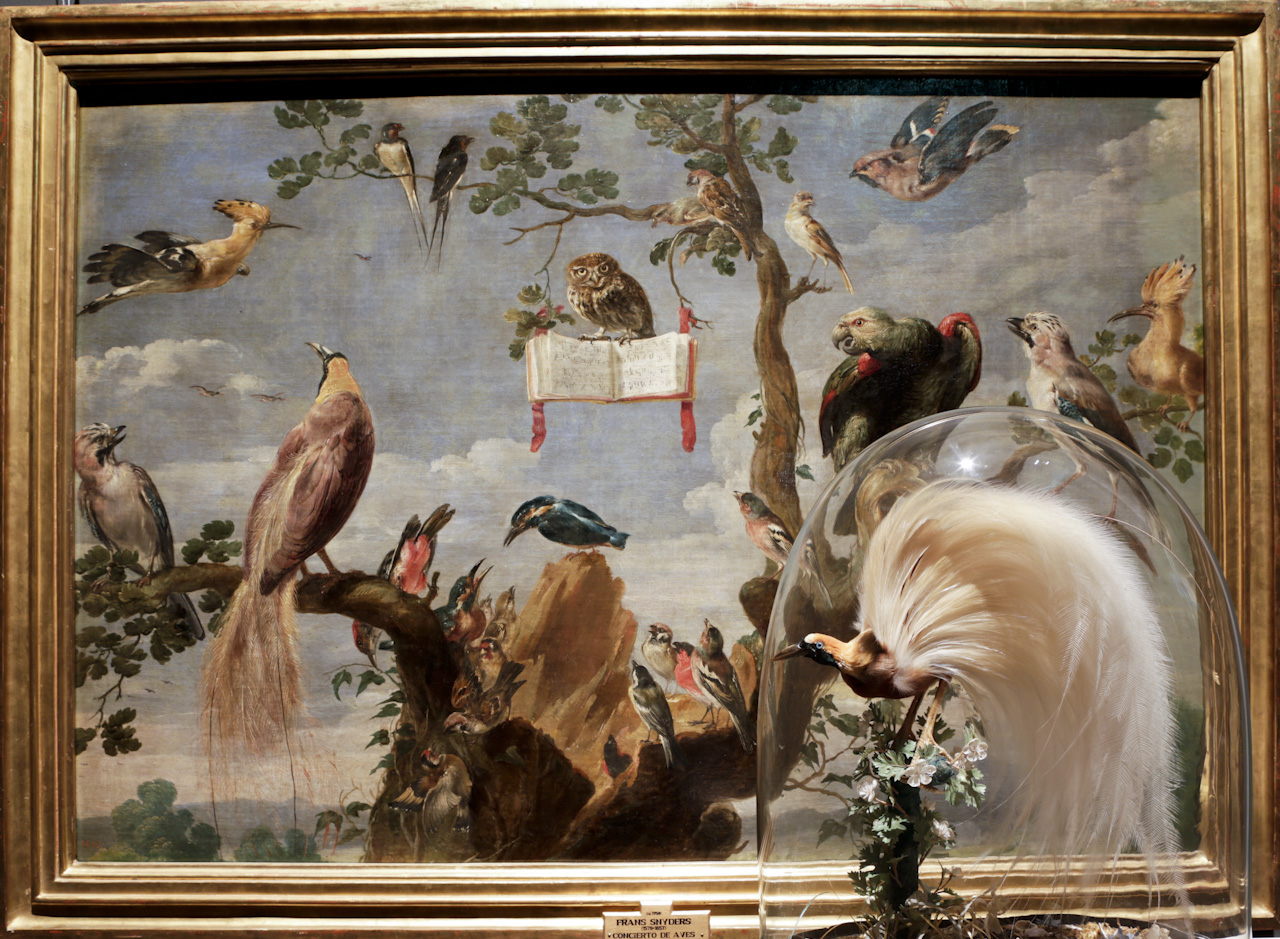
Frans Snyders, Concierto de aves (Museo del Prado)
Intérpretes:
Mochuelo europeo. Athene noctua
Abubilla. Upapa epops
Golondrinas. Hirunda rustica
Gorrión común. Passer domesticus
Bisbita campestre. Anthus campestris
Arrendajo. Garrulus glandarius.
Ave del paraíso de Raggi. Paradisaea raggiana
Amazona frentiazul. Amazona aestiva
Camachuelo. Pyrrhula pyrrhula
Carbonero común. Parus major
Ampeis europeo. Bombycilla garrulus
Martín pescador. Alcedo athis
Jilgueros, Carduelis carduelis
Picapinos. Dendrocopos martiius
Pinzón vulgar. Fringilla coelelos
Verderón común. Carduelis chloris
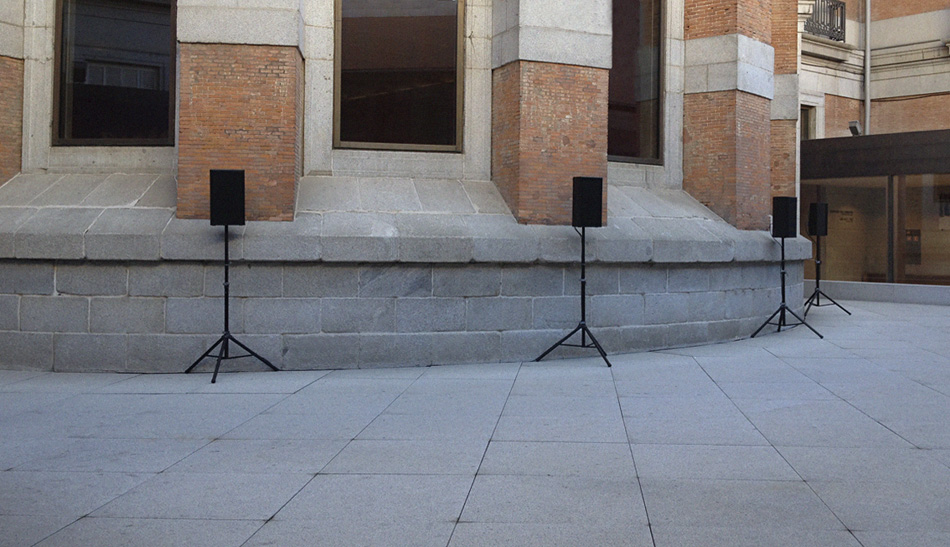
![]()
CONCIERTO
Commentor Vocis
Los hijos del aire: de alondras y ruiseñores
Museo del Prado. 21 de febrero de 2014
Programa
Miguel Ángel Blanco: Intervención sonora basada en las 16 especies representadas en Concierto de aves.
De pájaros
John Hilton the Younger (ca.1599-1657): As Flora slept
Thomas Ravenscroft (ca.1582-1635): Of all the Birds
Luca Marenzio (1553-1599): Vezzosi Augelli
De alondras
Felix Mendelssohn (1809-1847): Lerchegesang Op.48/4
Clément Janequin (ca.1485-1558): Le Chant de L´Alouette
De ruiseñores
Thomas Ravenscroft: By a bank,
Felix Mendelssohn: Die Nachtigall Op.59/4
Thomas Weelkes (1576-1623): The Nightingale
William Byrd (ca.1540-1623): The Nightingale
Clément Janequin: Le Rossignol
De aves
Nicolas Gombert (ca.1495-ca.1560): Le Chant des oyseaux
Clément Janequin: Le Chant des oyseaux
Felix Mendelssohn: Die Waldvögelein Op.88/4
RESERVA NATURAL, ‘Los hijos del aire: de alondras a ruiseñores’
12 de marzo de 2014
Los hijos del aire: de alondras a ruiseñores es el título de un concierto completamente novedoso interpretado por el grupo vocal Commentor Vocis en el Museo del Prado. Dos de sus componentes -Héctor Guerrero y Miguel Bernal- visitan la Reserva Natural de Radio 5 y nos presentan distintas piezas musicales de Mendelssohn, Gombert, Marenzio o Janequin inspiradas en las aves. Todo ellos forma parte del proyecto de Miguel Ángel Blanco «Historias naturales» que se puede ver en la pinacoteca hasta el mes de mayo.

‘Los hijos del aire: de alondras a ruiseñores’
The Madrid born Blanco, who is one of the principal Spanish artists directly associated with nature, emphasises the Museum’s historical side through 22 interventions that aim to fuse art and nature, located in the galleries of the Permanent Collection. Animal, vegetable and mineral objects selected by Blanco from Spanish natural history collections such as those of the Museo Nacional de Ciencias Naturales, the Real Jardín Botánico and the Museo de la Farmacia Histórica, establish a dialogue with the paintings and sculptures in the Museum and “intervene” to take the visitor on a new “scientific-artistic” expedition.
The Museo del Prado is presenting the exhibition Historias Naturales. A Project by Miguel Ángel Blanco, organised with the collaboration of the Higher Council for Scientific Research (CSIC) and the support of the Region of Madrid. 150 objects from the natural world make up the twenty-two interventions installed in the Museum’s galleries by this Madrid-born artist. Most of the objects – animals, plants and minerals – have been loaned by the Museo Nacional de Ciencias Naturales of the CSIC, displayed alongside 25 works from the Museum’s own collection. The result is a close dialogue with these 25 works of art and also with the building itself and the urban setting of the Paseo del Prado. Through this exhibition the Prado is paying tribute to its own history and to the origins of its building, originally designed as a Natural History museum. On 19 November 1819 the Prado opened its doors to the public for the first time as the Museo Nacional de Pinturas y Esculturas (National Museum of Paintings and Sculptures). However, the Neo-classical building designed by Juan de Villanueva that now houses the Prado was originally designed as the Royal Natural History Cabinet on the orders of Charles III in 1785.
To celebrate the anniversary of the Museum’s first opening to the public on 19 November 1819, the Prado will be introducing visitors to a lesser known aspect of its history, namely that of its origins as a natural history museum prior to its inauguration as the Museo de Pintura y Escultura.
The building that now houses the Museum was designed by the architect Juan de Villanueva in 1785 as the Natural History Cabinet on the orders of Charles III. Now, for a period of almost six months the galleries of the Permanent Collection will display objects including some of those that the monarch acquired from the collector and naturalist Pedro Franco Dávila for his new natural history museum, which was previously located in the Palacio de Goyaneche (now the headquarters of the Academia de Bellas Artes de San Fernando).
The exhibition
Natural Histories. A project by Miguel Ángel Blanco consists of twenty-two interventions in the Prado’s galleries, made up of 150 objects from the natural world (minerals, stuffed or preserved animals, skeletons and insects), the majority from the Museo Nacional de Ciencias Naturales, shown alongside twenty-five works from the Museum’s collection. The result is to establish a close relationship between them and also with the building itself and the surrounding urban context of the Paseo del Prado.
Visitors will thus be able to see the realisation of Charles III’s desire to house a Natural History museum in the Villanueva Building. Due to the circumstances of history, the arts and sciences coexisted under the same roof on two occasions: in 1827 and during the Civil War when objects from the collections of the Real Jardín Botánico and the Museo de Ciencias were moved to the Prado for greater safety. In order to bring about this reencounter with the Museum’s history and origins, the artist Miguel Ángel Blanco has not set out to reconstruct the Natural History Cabinet three hundred years later. Rather, as he explains: “What I have done in the Museo del Prado is to evoke that collection, the ghost of which inhabits the Villanueva Building. The twenty-two artistic interventions create a collection for the future, incorporating a creative viewpoint, interacting with the Permanent Collection and encouraging a new way of looking at the works which helps to increase the significance of the images.”
The first intervention is to be seen in the Ariadne Rotunda in the Museum, in which the preeminent work is the large-scale, recently restored sculpture of the Sleeping Ariadne (anonymous sculptor, 150-175AD). Next to it is the sculpture of Venus with a Dolphin (anonymous sculptor, 140-150AD), who now becomes the principal focus of this space. From the room’s ceiling Blanco has suspended a dolphin’s skeleton from the Museo Nacional de Ciencias Naturales, explaining that “the marble-like bones of the skeleton resemble the ivory-like marble of the sculptures”. The skeleton projects its shadow over Venus, “leaping like a Leviathan to swallow up the goddess […].”
Another of the works that best sums up Blanco’s work in the Museum is his intervention based on Joachim Patinir’s celebrated painting Charon crossing the Styx. Patinir’s work, which is among those that has most fascinated Blanco, ceases to be a painting and becomes an extension of the lake. It is transformed into pigment by the placement immediately in front of it of a giant piece of azurite (Museo Nacional de Ciencias Naturales), the source of the copper carbonate that Patinir used as a pigment in his painting, “which we can imagine as the result of the lake drying up, assisted by the similarity between the shape of its outline and that of the stone.”
Room 55B in the Prado is another space transformed into a natural history collection by Blanco through his introduction of the skeleton of a snake wound round itself, located next to Dürer’s two panels of Adam and Eve. The skeleton is one of the most beautiful objects in the Museo de Ciencias Naturales’ reptile collection. Through this juxtaposition, Dürer’s two nude studies remind us even more forcefully of the subject of human proportions, which Blanco considers “a scientific endeavour”. Here he reveals an aesthetic intent in his placement of the skeleton, while “the snake’s flexibility resulting from its numerous vertebrae echoes the sinuosity of Dürer’s figures.”
Blanco’s twenty-two installations are completed with one of his own works, Book-box no. 1072, which is part of the work for which he is best known, the Forest Library. It consists of 1,131 book-boxes housing natural elements, each one forming a micro-landscape. The book-box that he has chosen for this intervention acquires meaning in front of Lucas van Valckenborch’s Landscape with an Iron Works of 1595. According to Blanco, this is one of his boxes most oriented towards landscape and can be visually related to the landscape paintings in the Room 57 of the Museum: “Among these Flemish painters I feel close to Lucas van Valckenborch, who depicted himself in some of his works with a sketchbook on his lap, reflecting the practice of observing the landscape at first hand […].” “Of all natural environments, the forest is my place and the tree my equal.” (www.bibliotecadelbosque.net)
Reportaje de Carlos del Amor en los informativos de rtve. Emitido el 19 de noviembre de 2013
En la web de rtve.
![]()
RADIO
Reserva Natural, Radio 5
‘Reserva Natural’, de Radio 5, hace una expedición artístico-científica por la exposición «Historias Naturales». Nuestro guía es Miguel Ángel Blanco, artista y creador de esta muestra que se desarrolla a través de 22 intervenciones en las que las obras del museo dialogan con objetos procedentes del Museo Nacional de Ciencias Naturales o el Jardín Botánico. Miguel Ángel Blanco trabaja desde hace años en la «Biblioteca del Bosque», compuesta por 1.133 libros-caja, uno de los cuales «Bosques negros», aparece expuesto en la muestra.

Un paseo por el Museo del Prado
El Bosque Habitado, Radio 3
Con Miguel Ángel Blanco descubrimos que el Museo del Prado nació para ser un Gabinete de Historia Natural, un Gabinete de Maravillas. Y, así, lo vivimos, casi 300 años después con este artista, autor de la Gran Biblioteca del Bosque, que interviene el Prado, como creador contemporáneo, de forma imaginaria, lo que fue y pudo haber sido, este templo del saber y del goce de los sentidos. Así que te invitamos a recorrer con nosotros esta original exposición que su autor, Miguel Ángel Blanco, ha llamado «Historias naturales», una muestra que podrás visitar con tus pies, tus oídos y tu espíritu hasta el próximo domingo, 27 de abril.
Oirás al ave del paraíso, escucharás el conservatorio para pájaros, las fuentes del Edén, dragones apocalípticos y bosques negros… También, también percibirás sonidos de otras dimensiones, pero no tengas miedo. Estarás entrando en territorio magno, artístico, atemporal y eterno… Tan sólo déjate guiar por la voz del maestro. Miguel Ángel Blanco te enseñará que hay muchos mundos en el Prado, que hay muchas eras en el Prado, que hay muchos habitantes, especialmente del bosque, en el Prado. Así que nos aventuramos en este viaje iniciático con la inspiración de Ignacio Abella, Fernando Fueyo, Raúl Tapia, Antonio Muñoz Molina, Miguel Zugaza y la Comunidad del Bosque… Enya inspira este viaje que nos enseña que sí, que «sic itur ad astra»… Que «Así se sube a las estrellas, que así es como uno se inmortaliza»…

El bosque interviene el Museo del Prado
![]()
PERIÓDICOS Y REVISTAS
(Click en la imagen para leer a página completa en pdf, o en el enlace para ver la publicación digital)
Babelia (+fotogalería)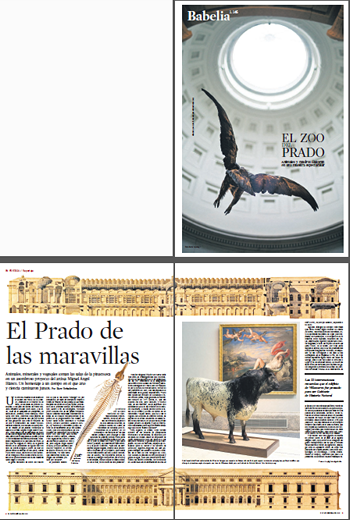 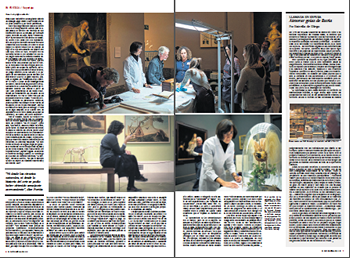 |
El Cultural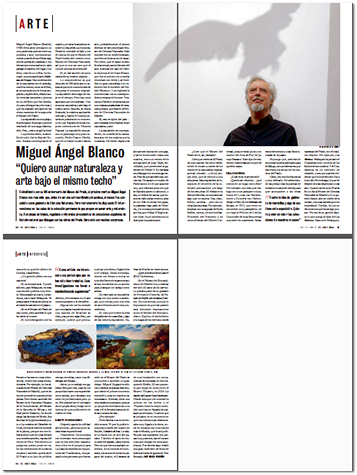 ABCD (+fotogalería) 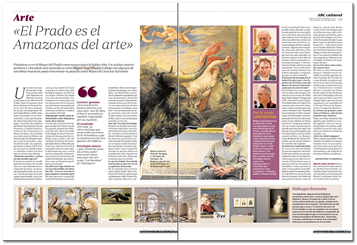 |
Ars Magazine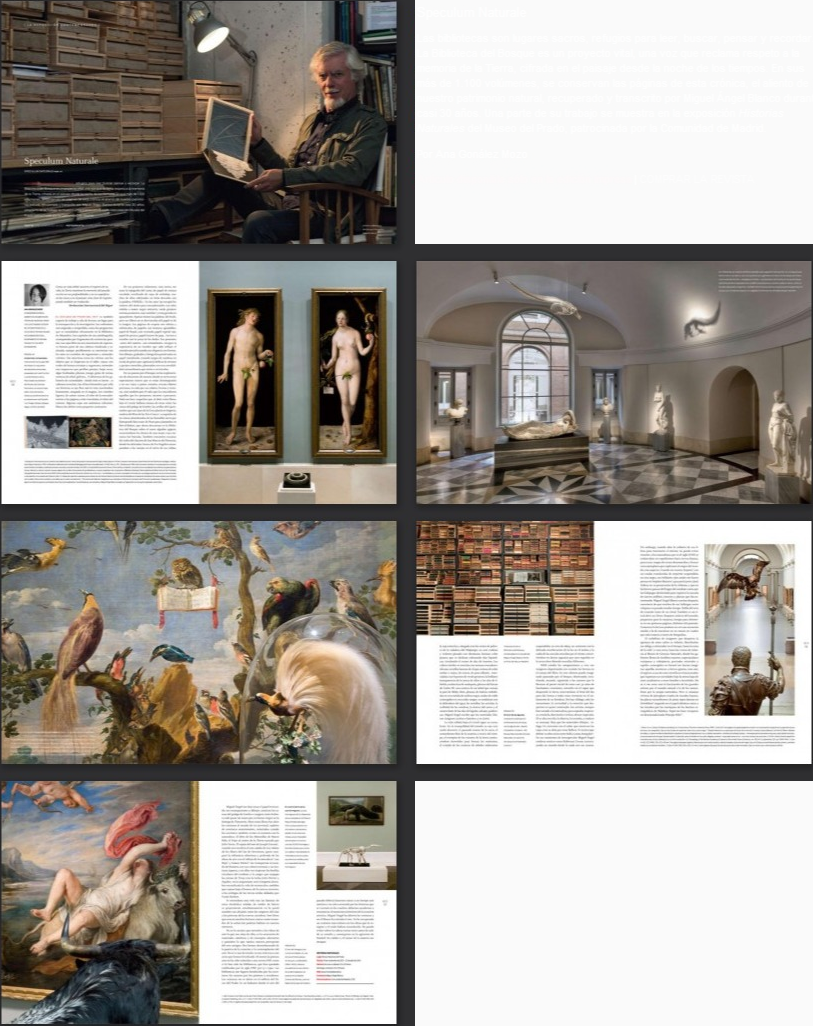 |
Descubrir el Arte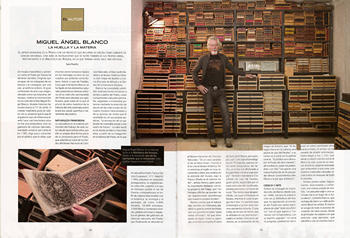 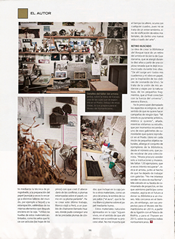 |
The Guardian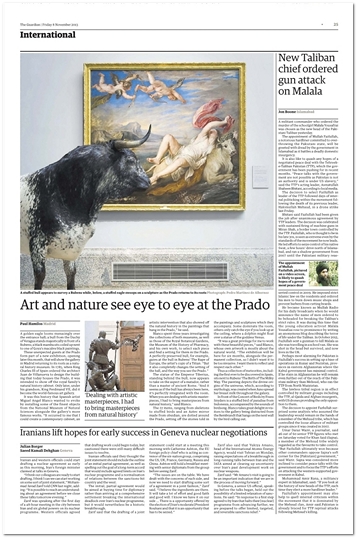 |
The New York Times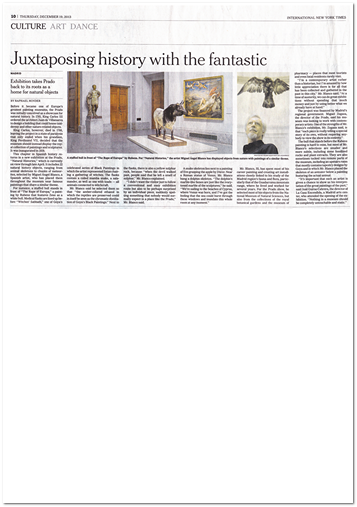 |
ABC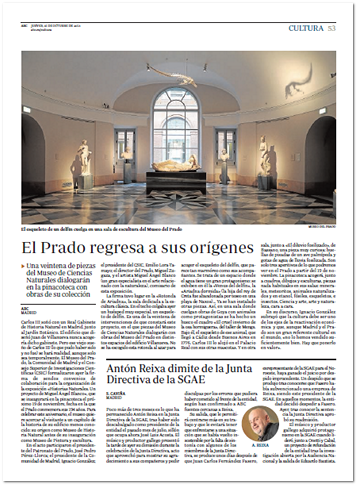 |
La Razón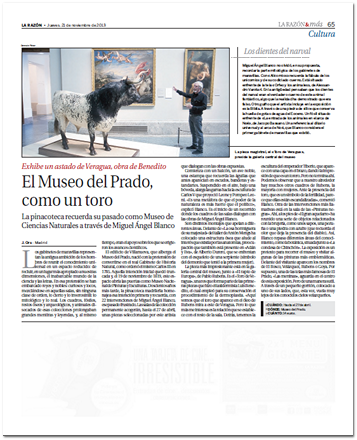 |
El Mundo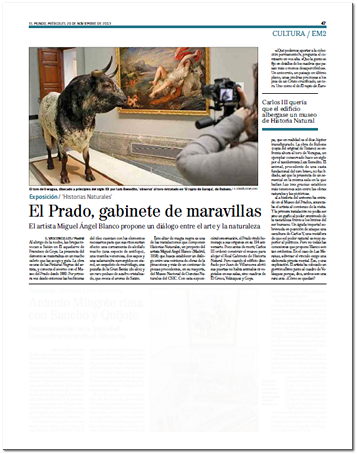 |
El Heraldo de Aragón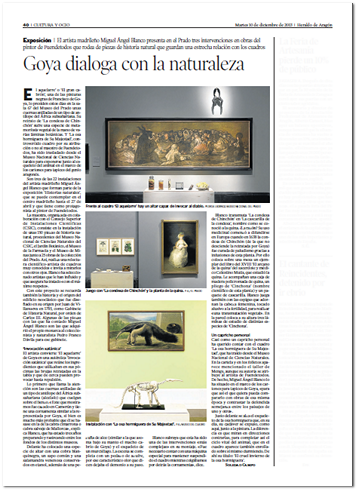 |
Diario de Navarra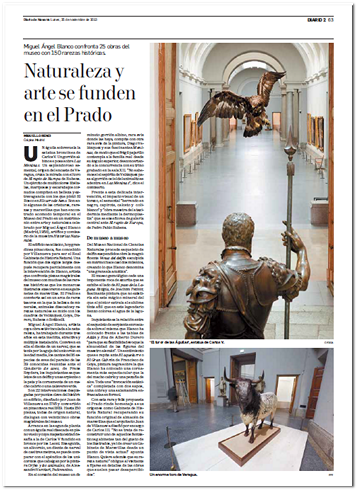 |
National Geographic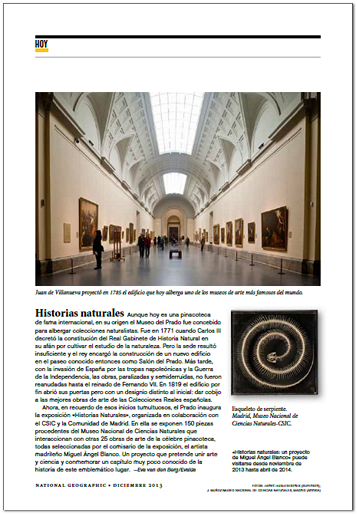 |
Times Higher Education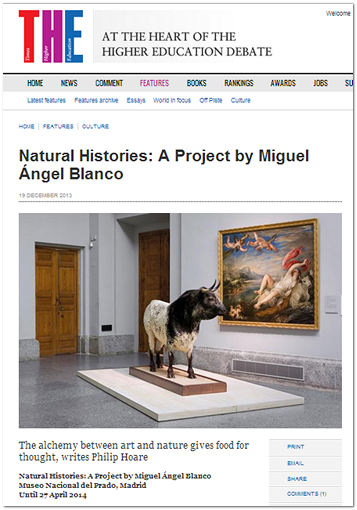 |
Science Magazine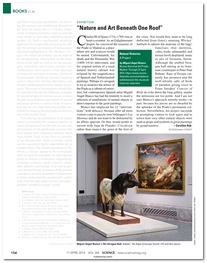 |
Babelia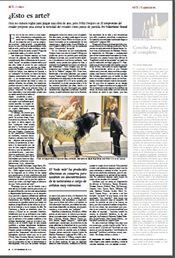 |
… |
